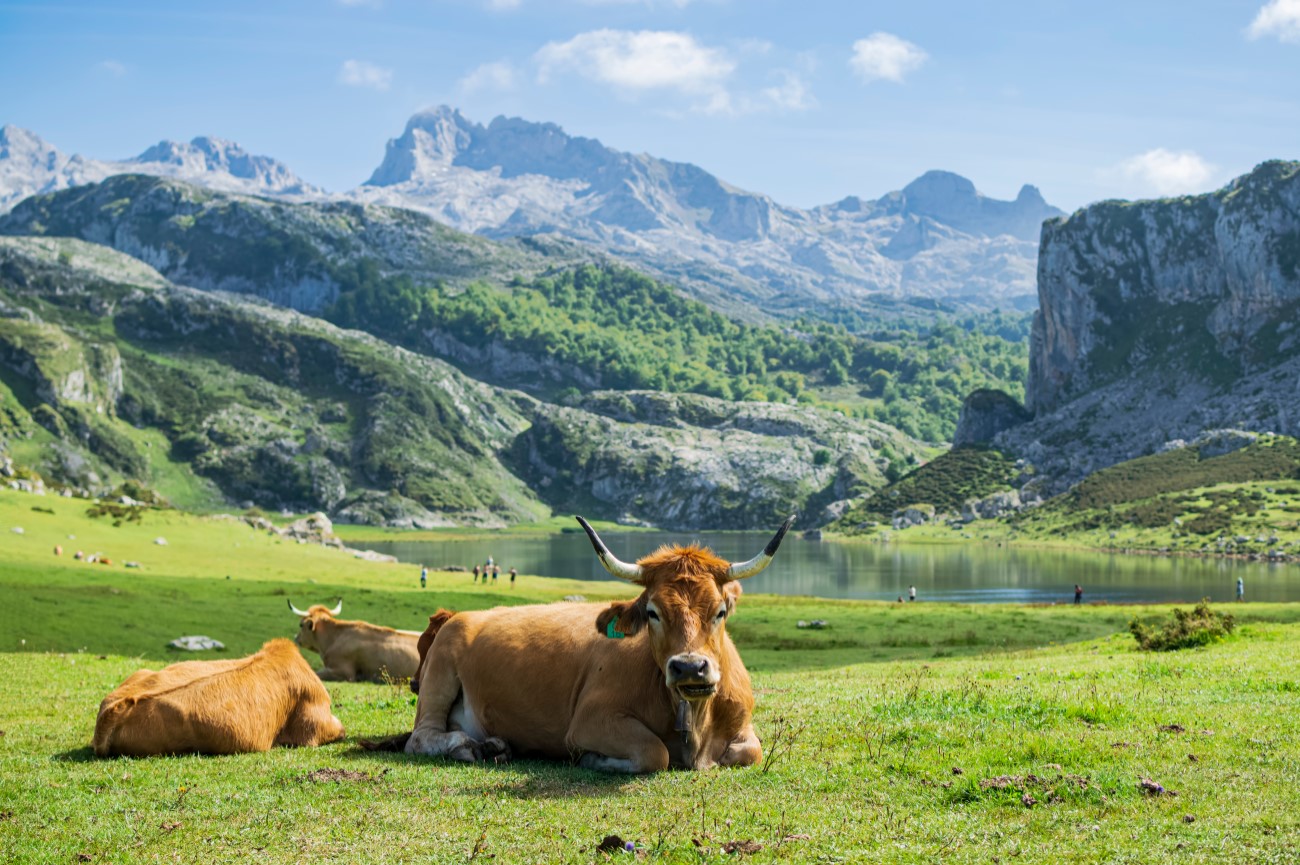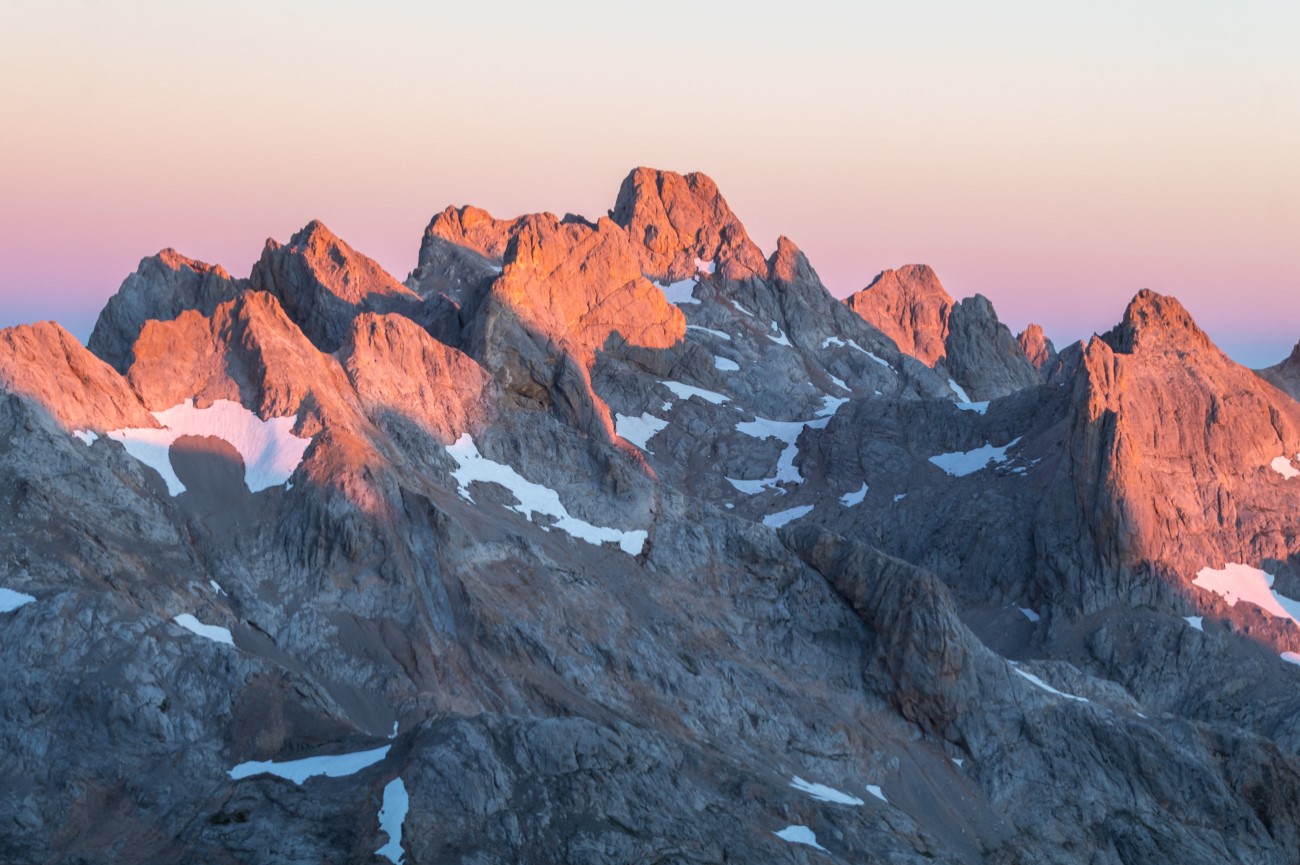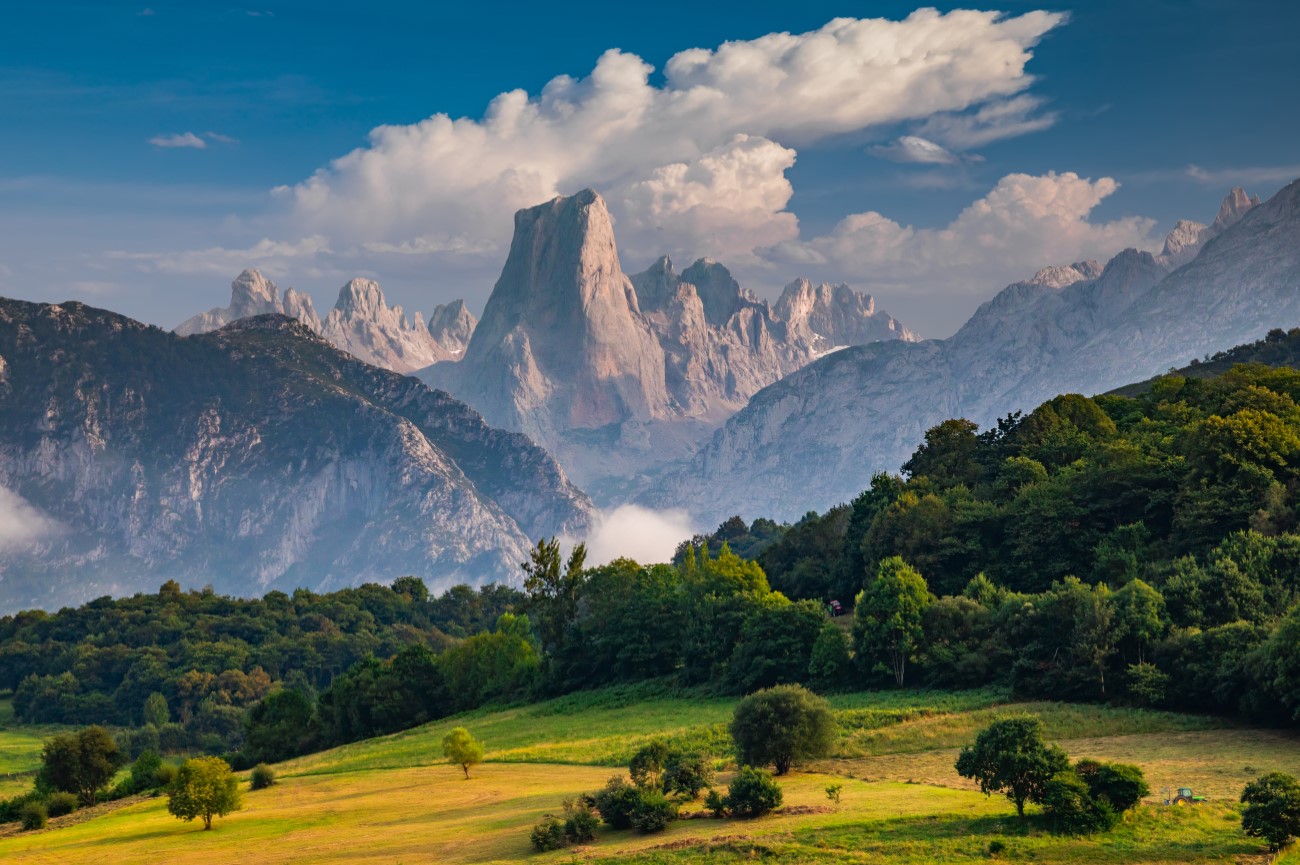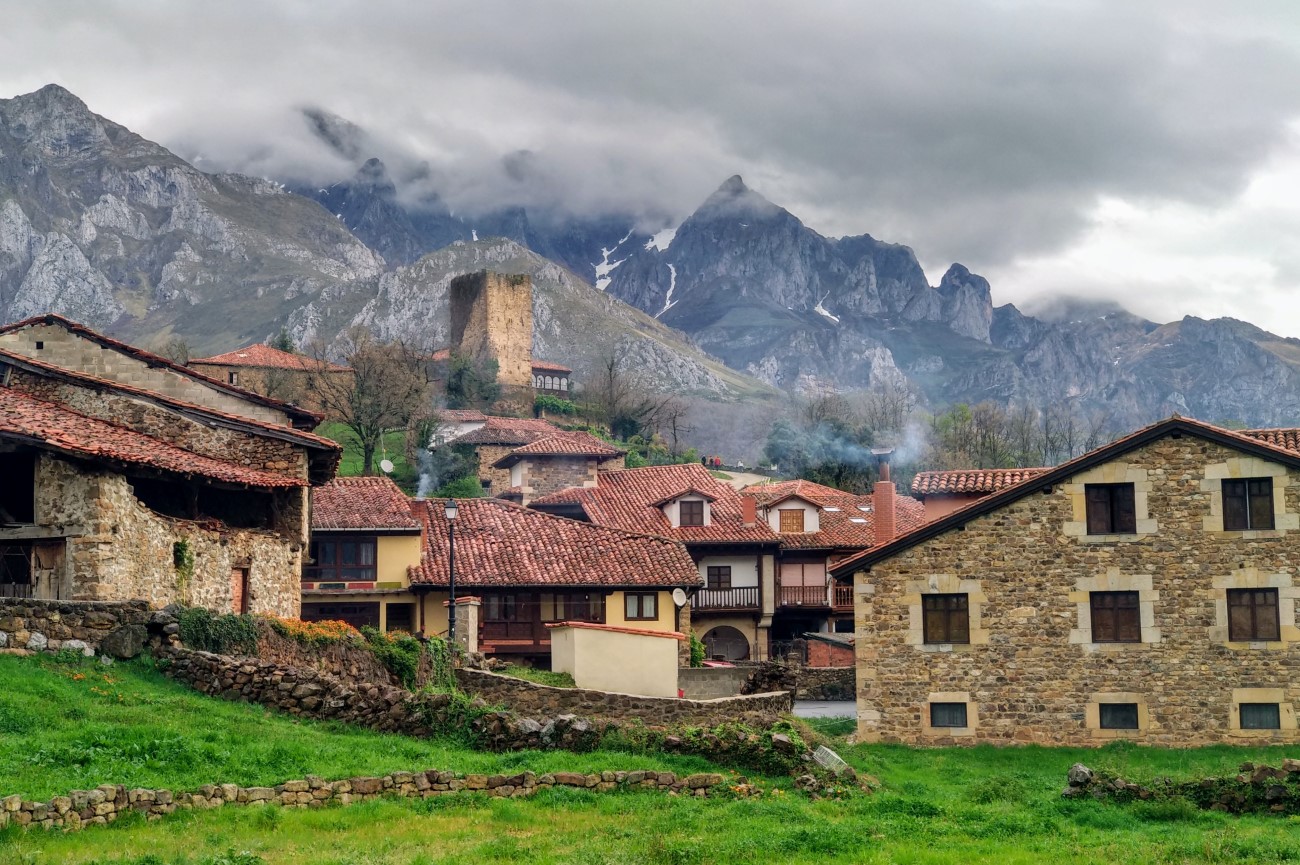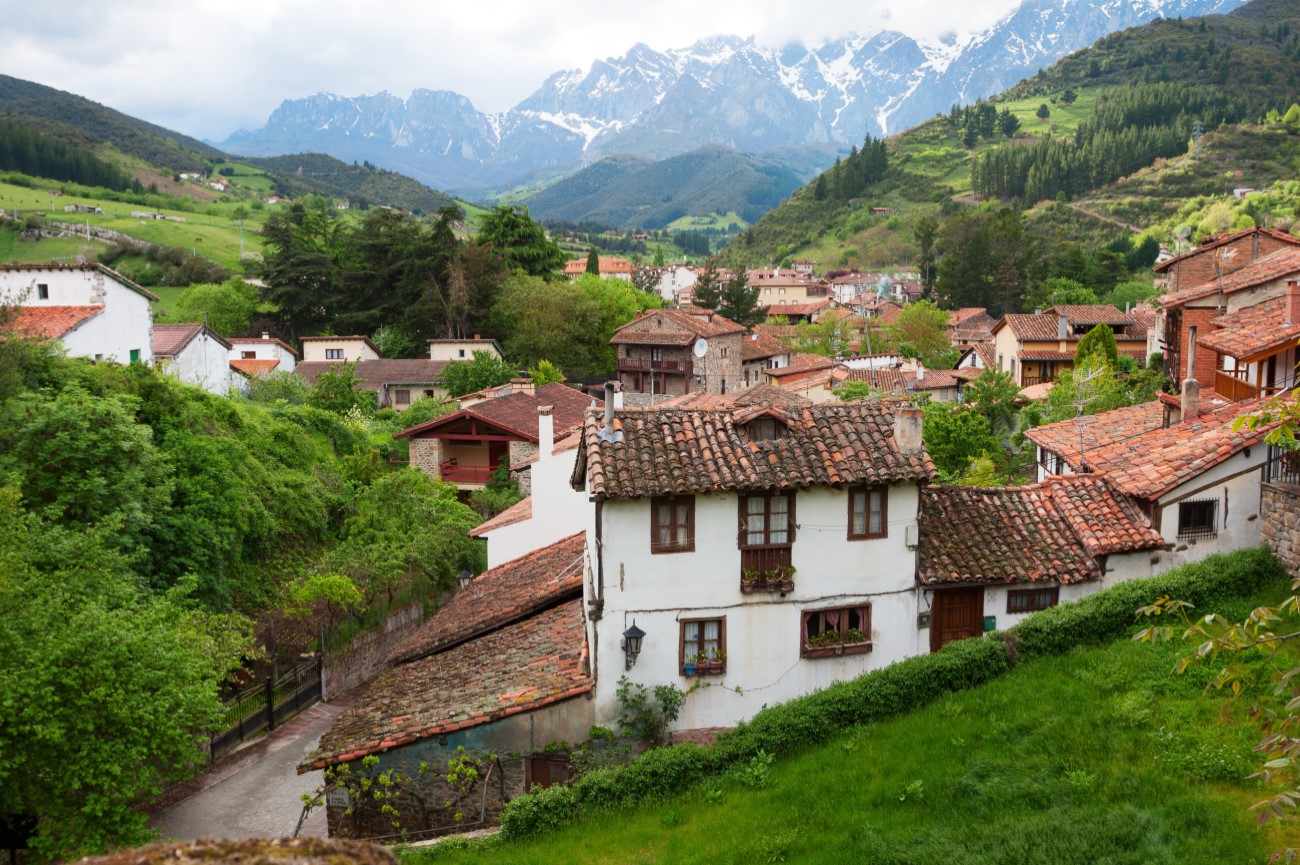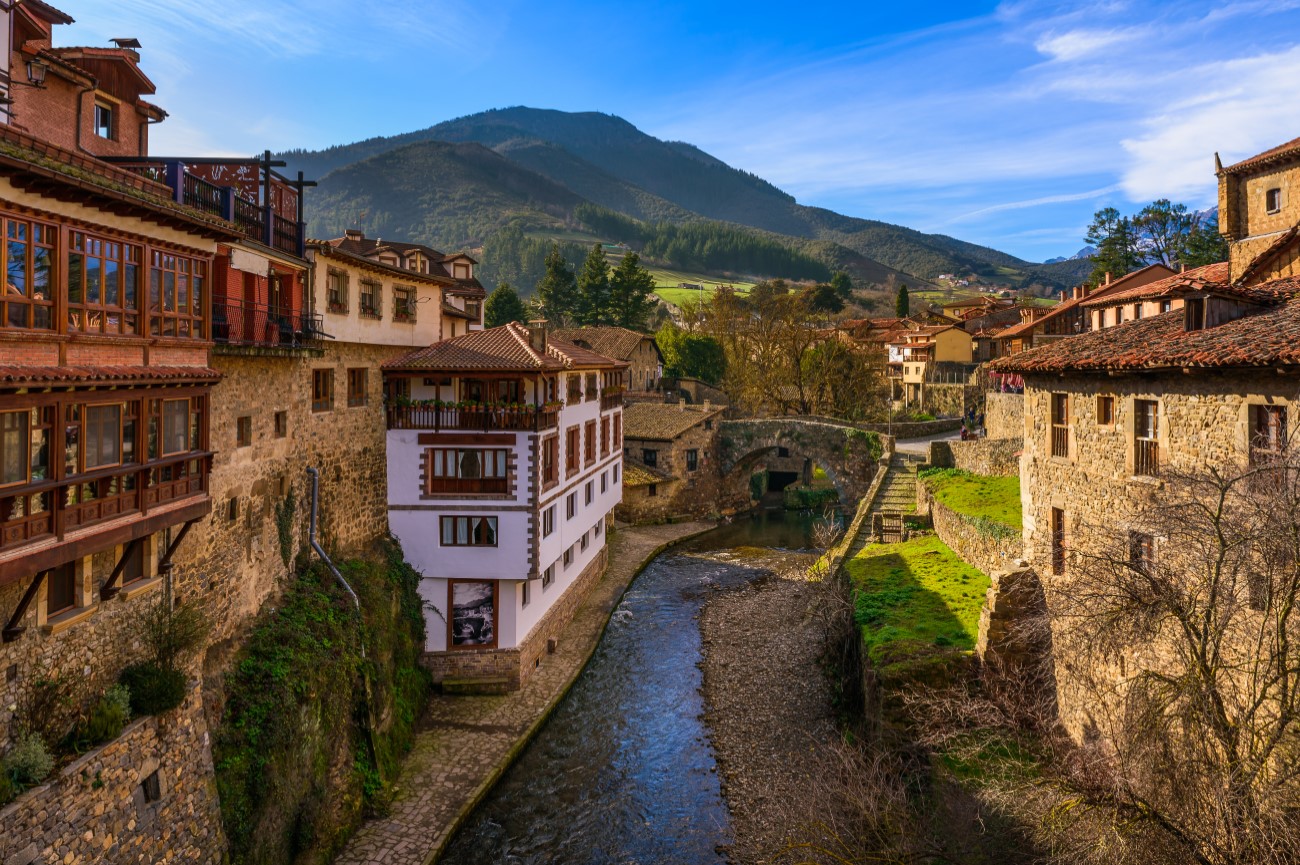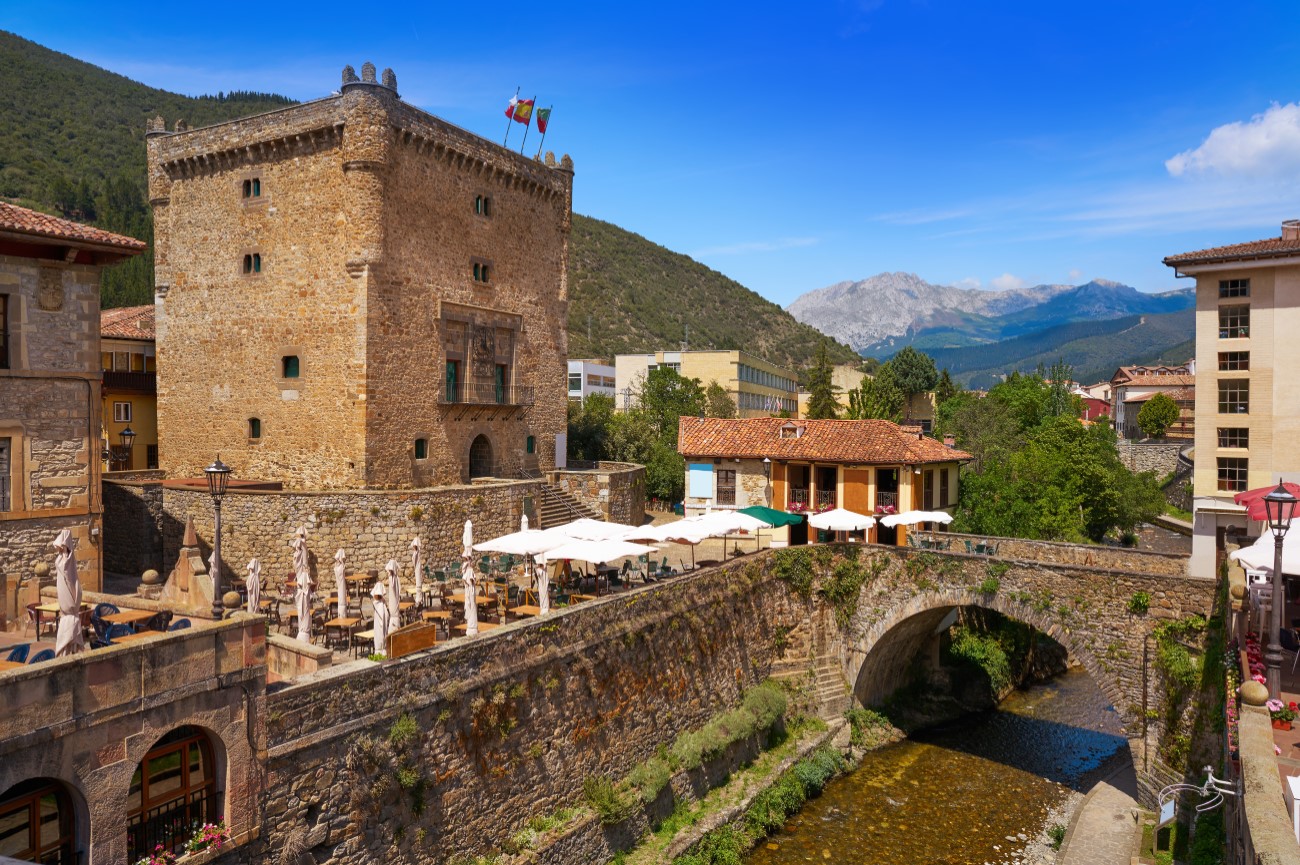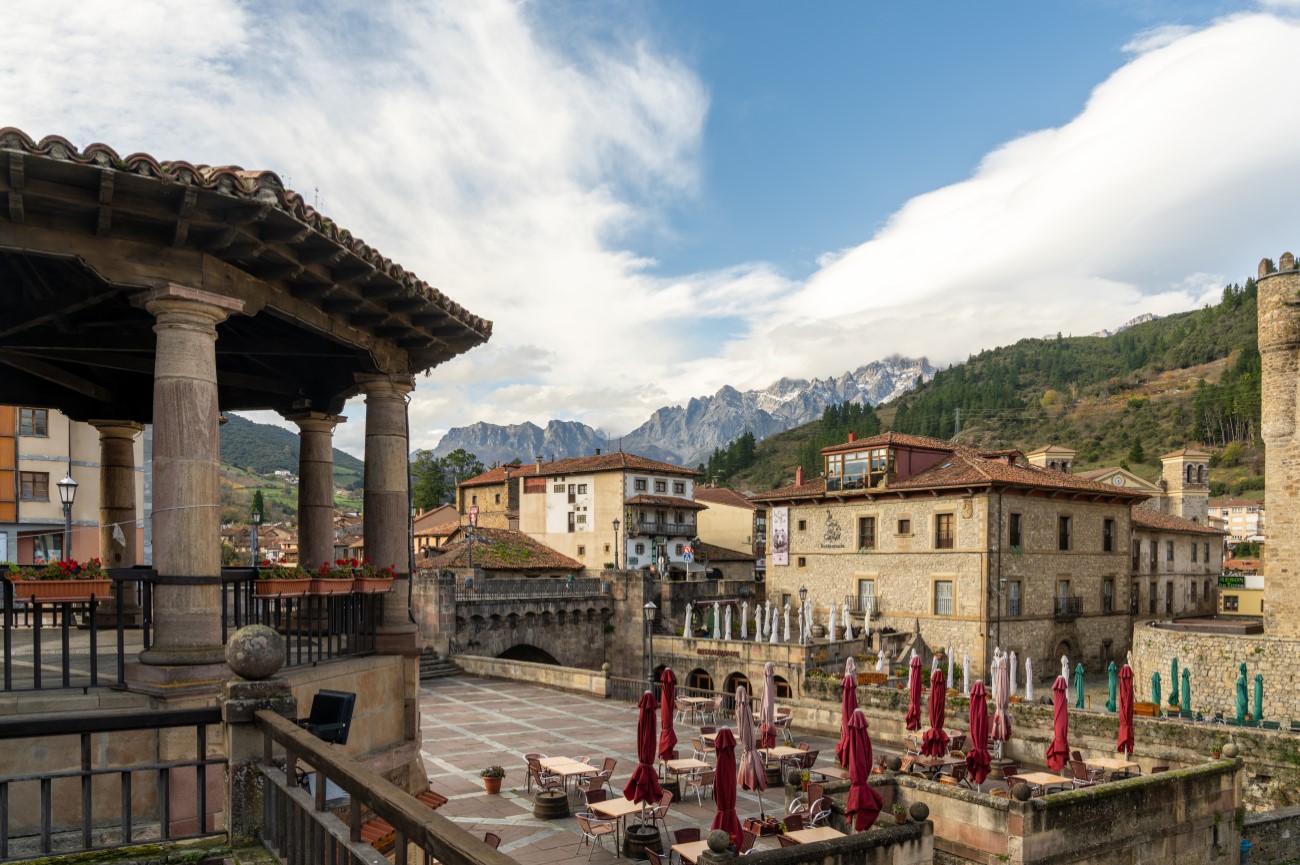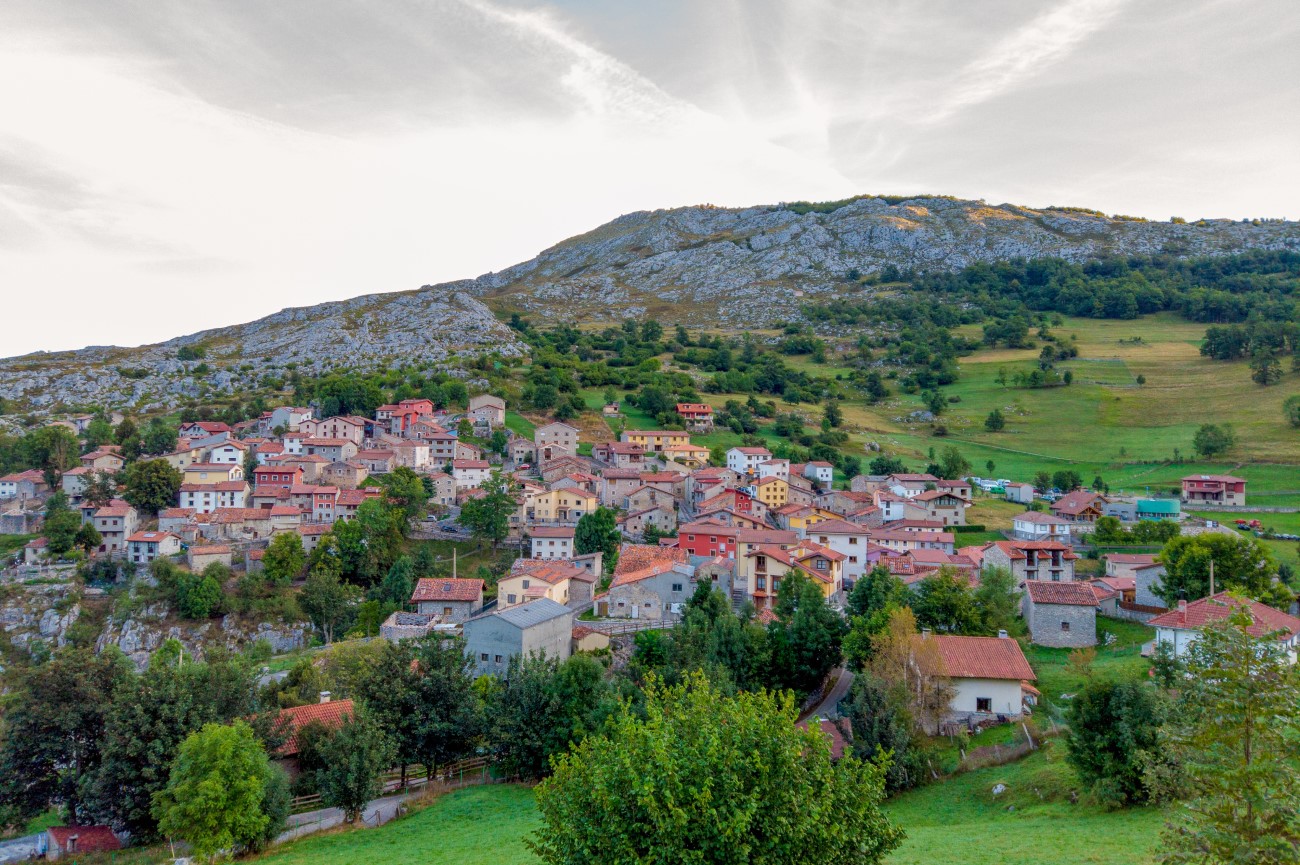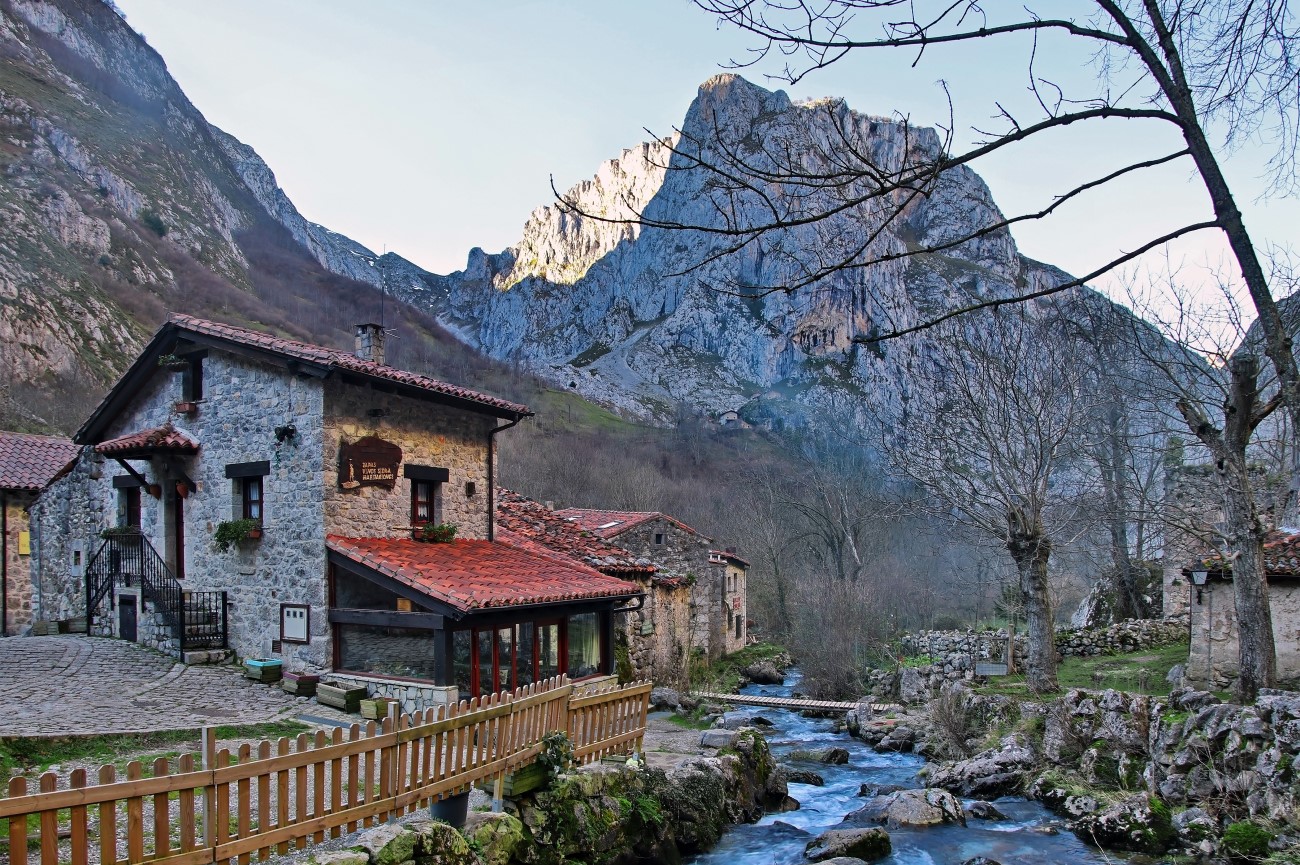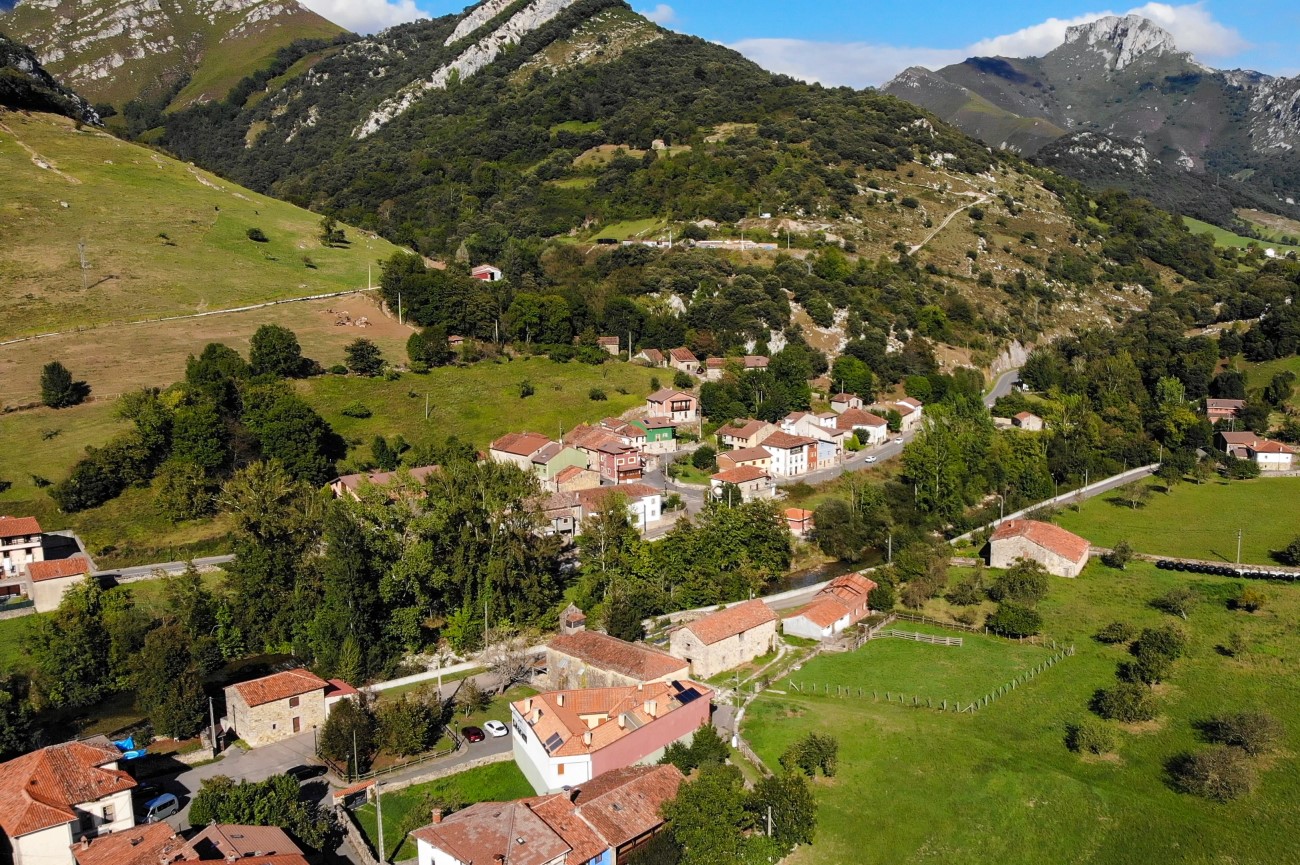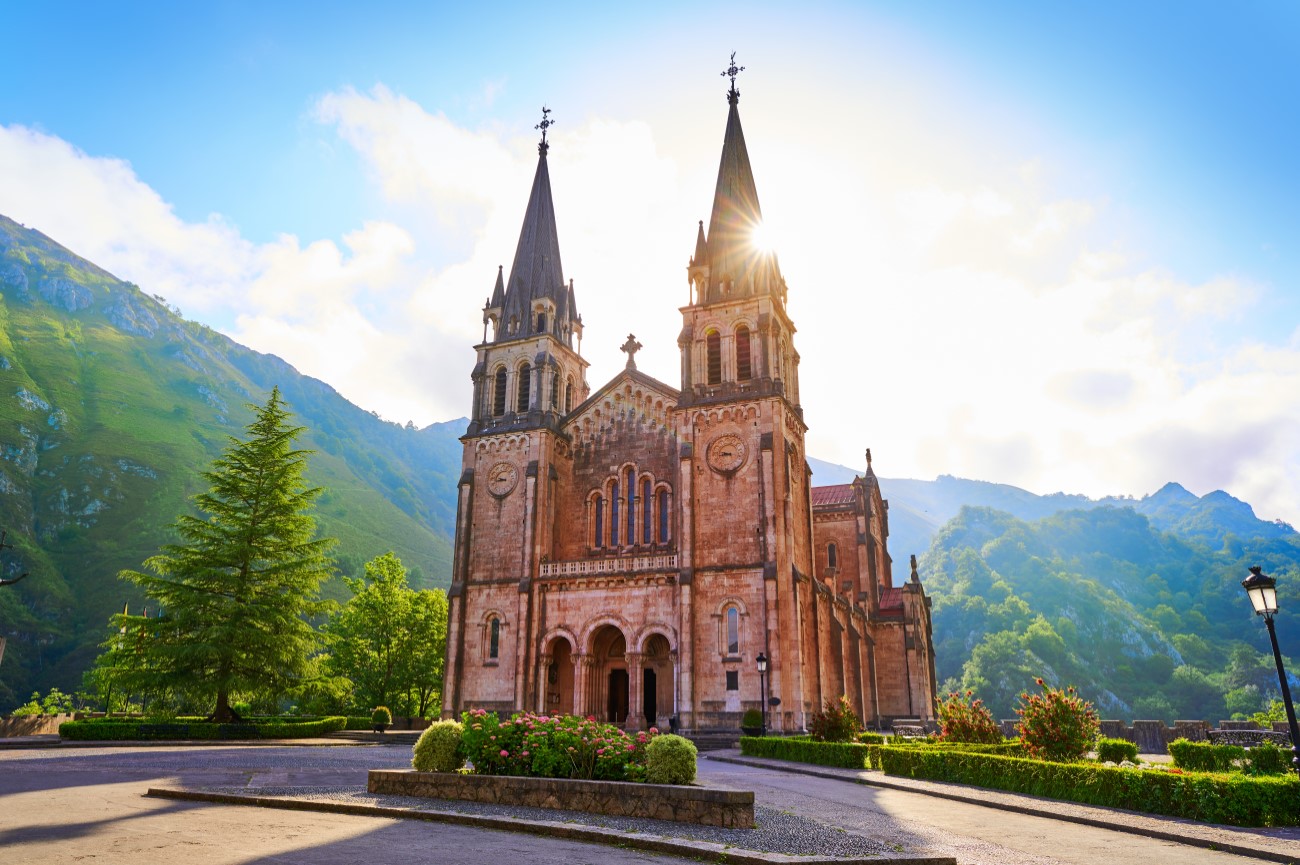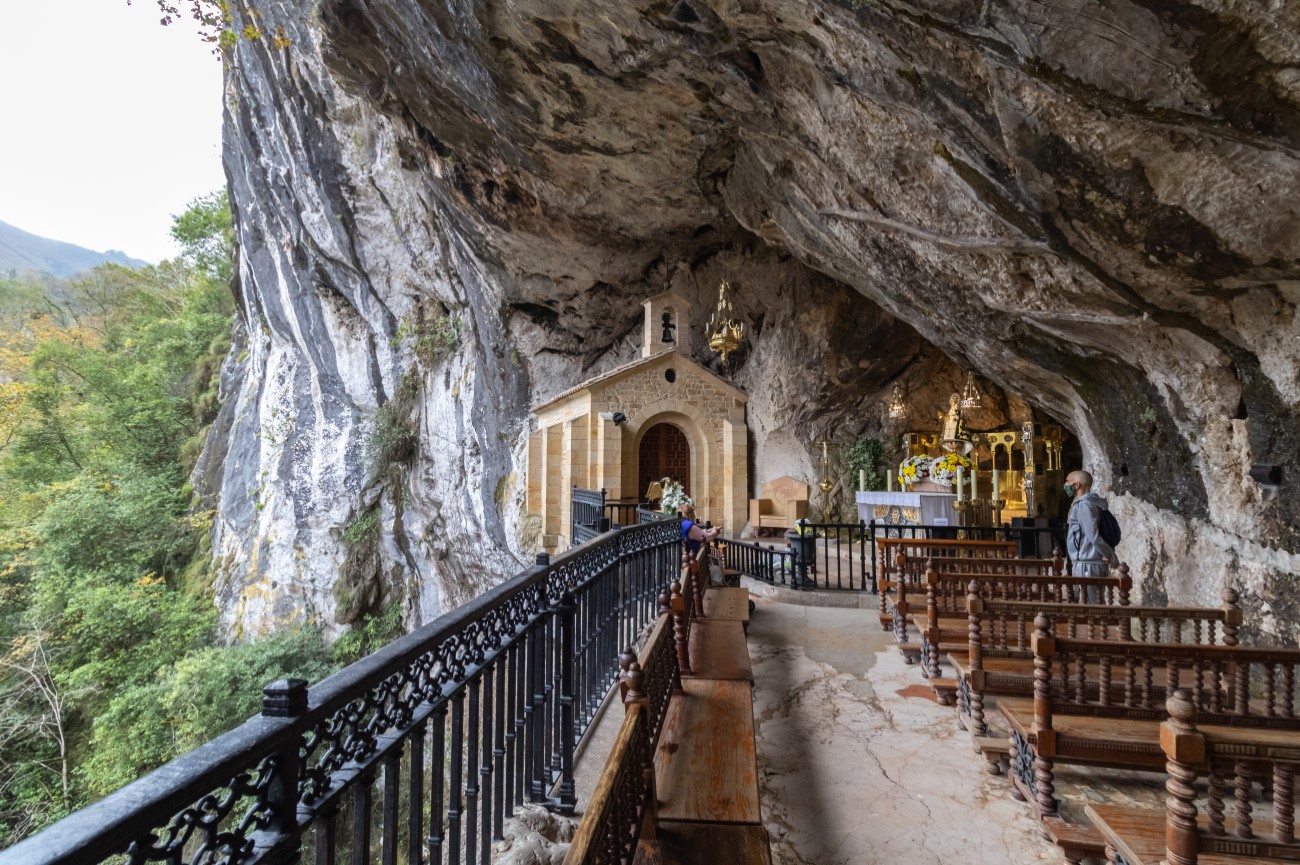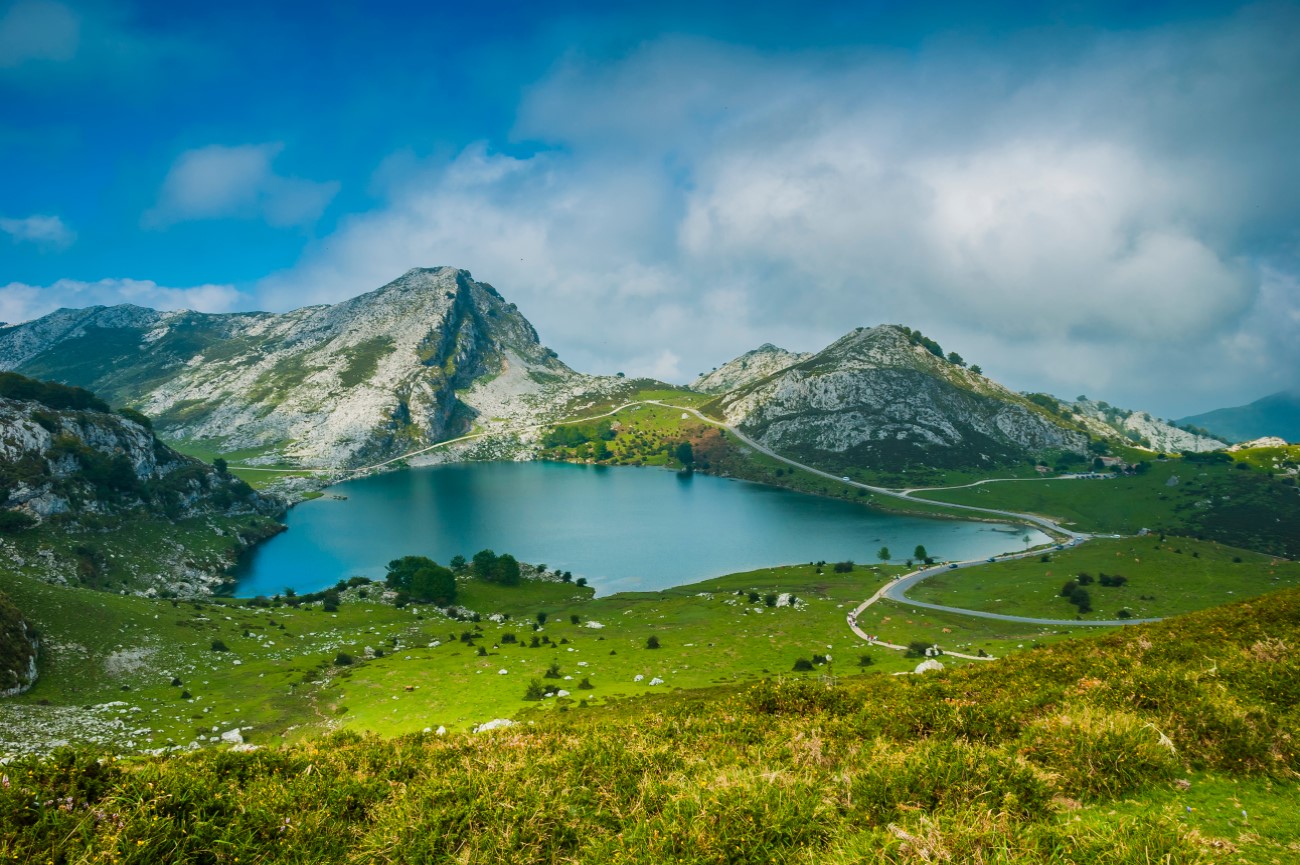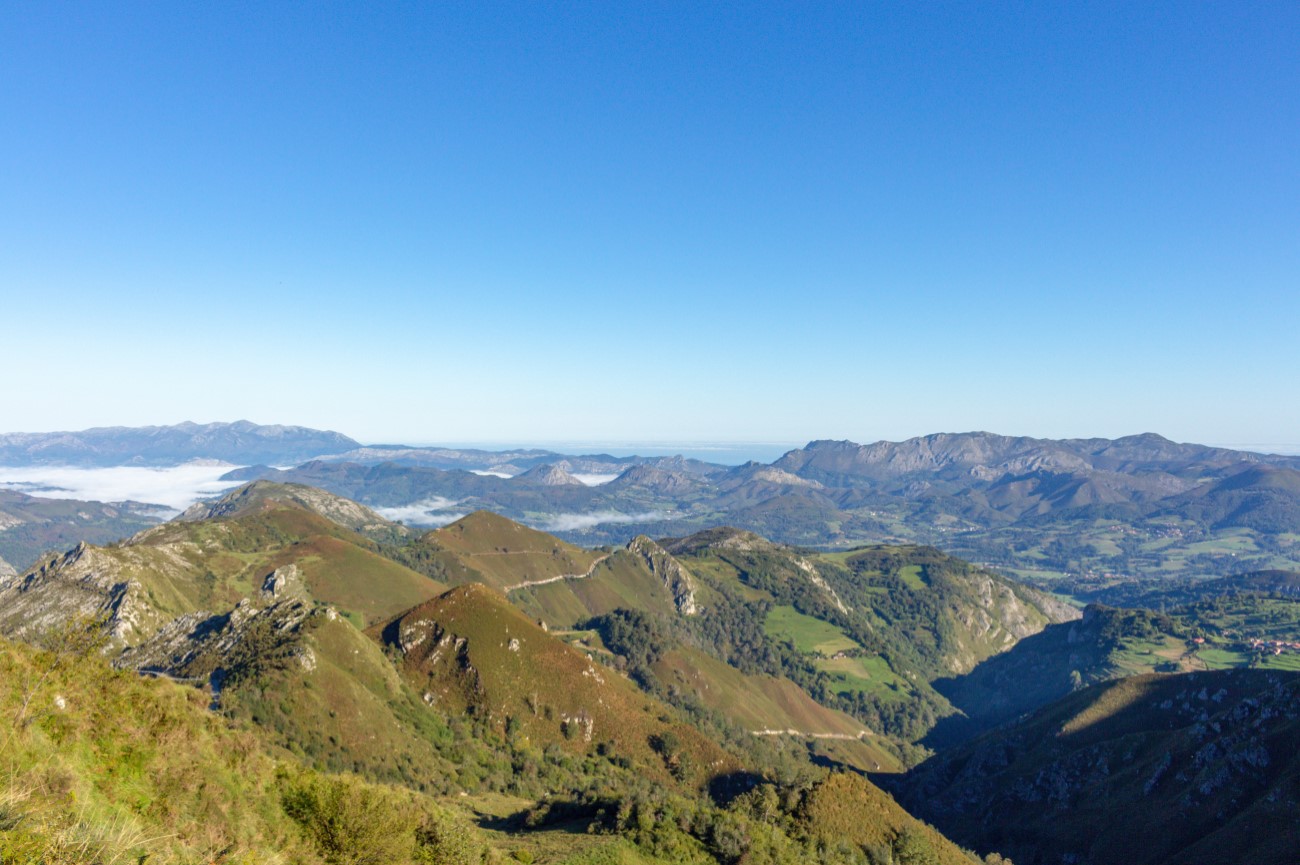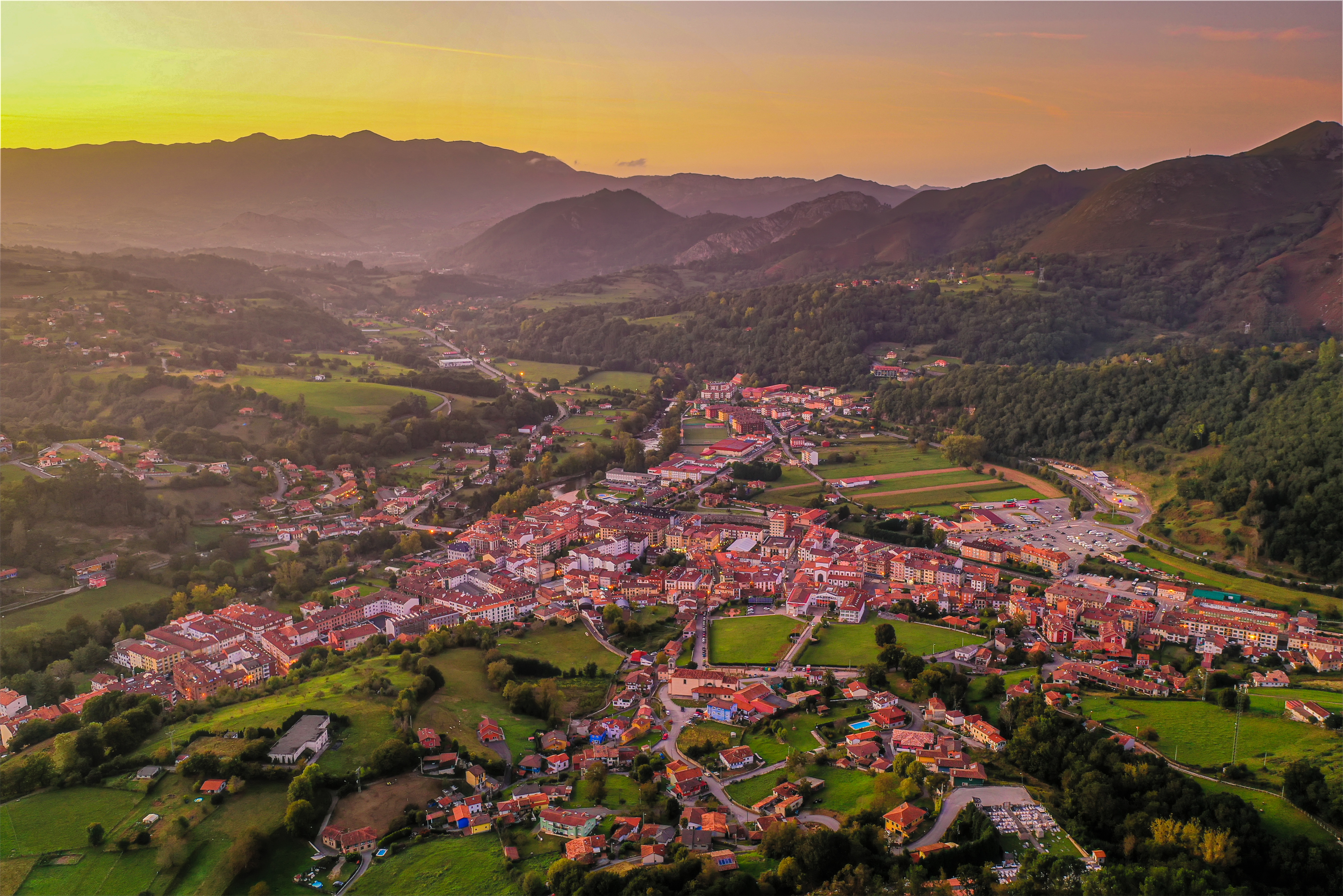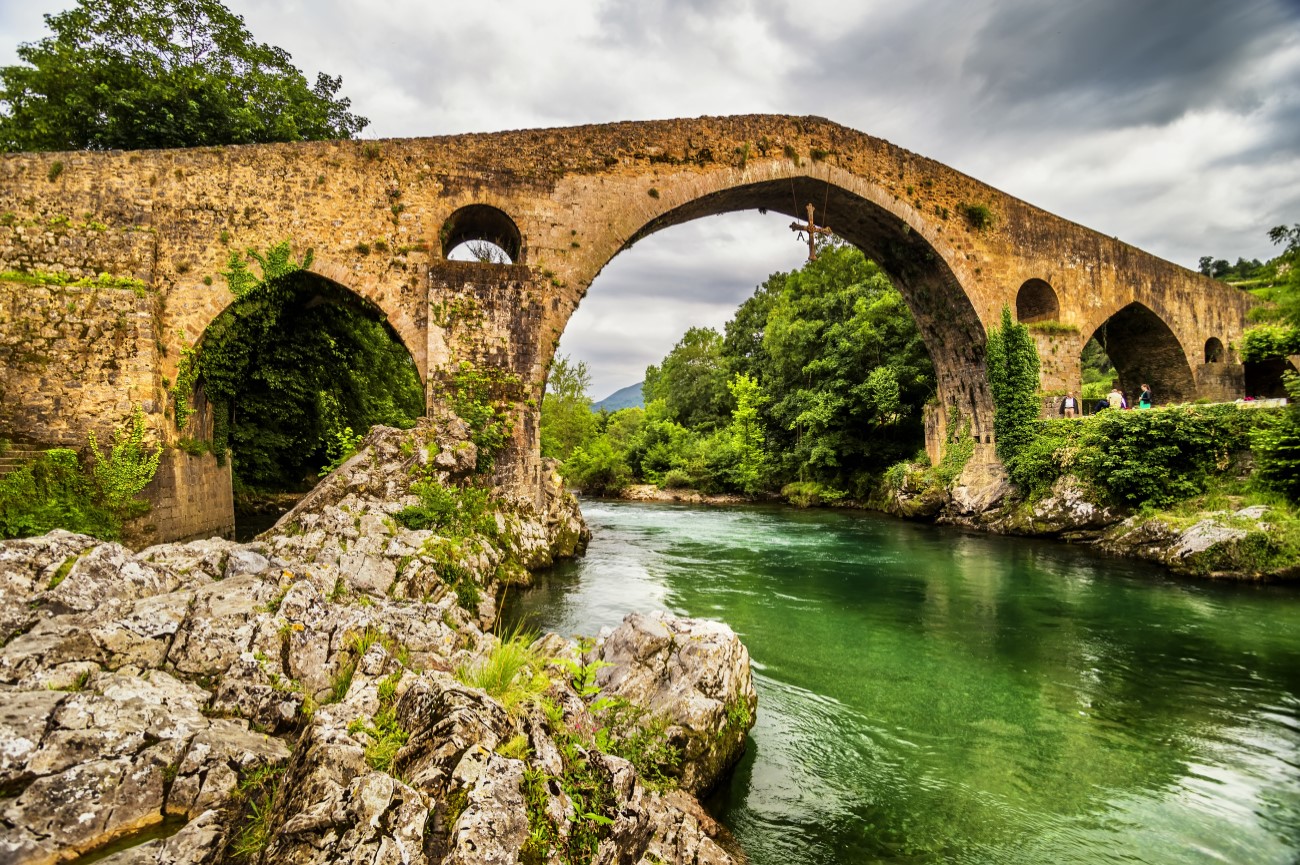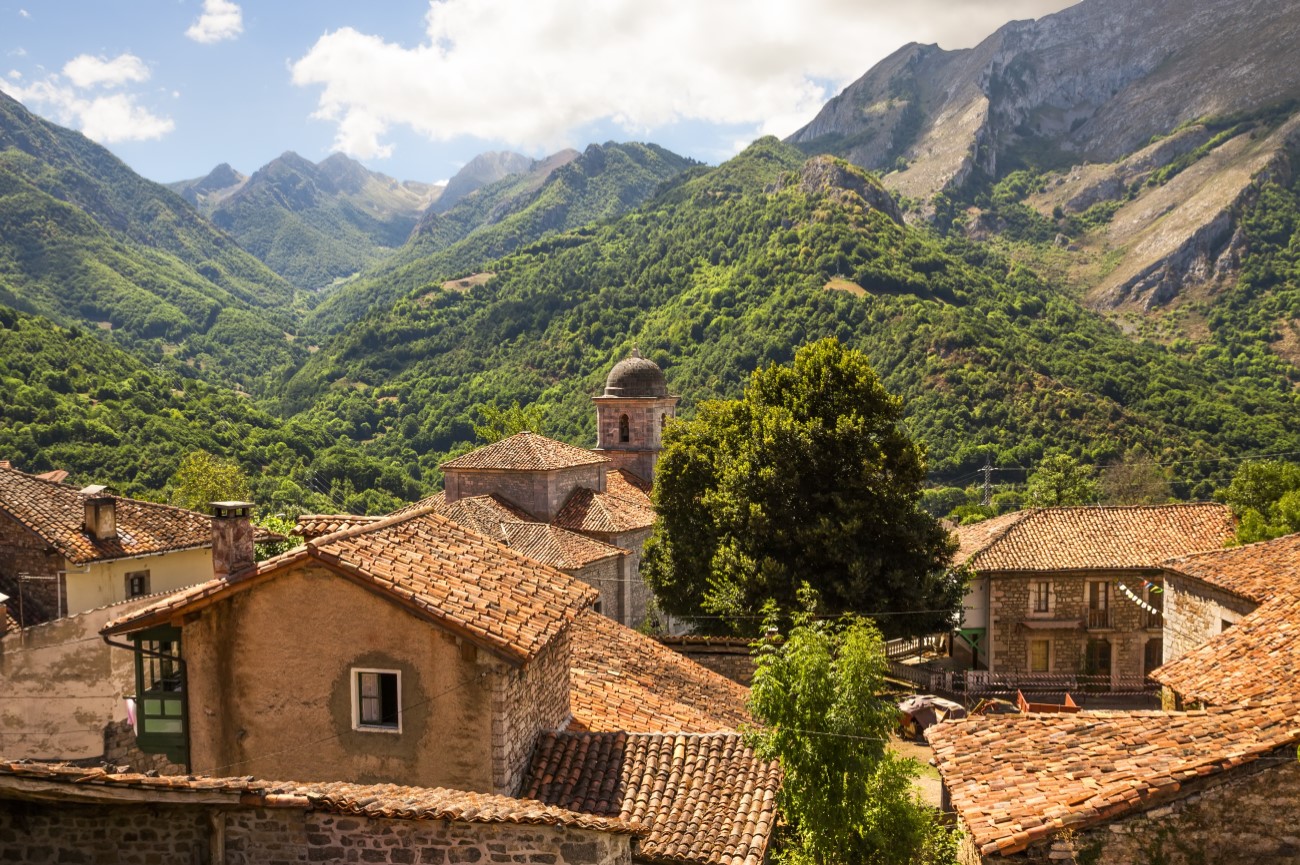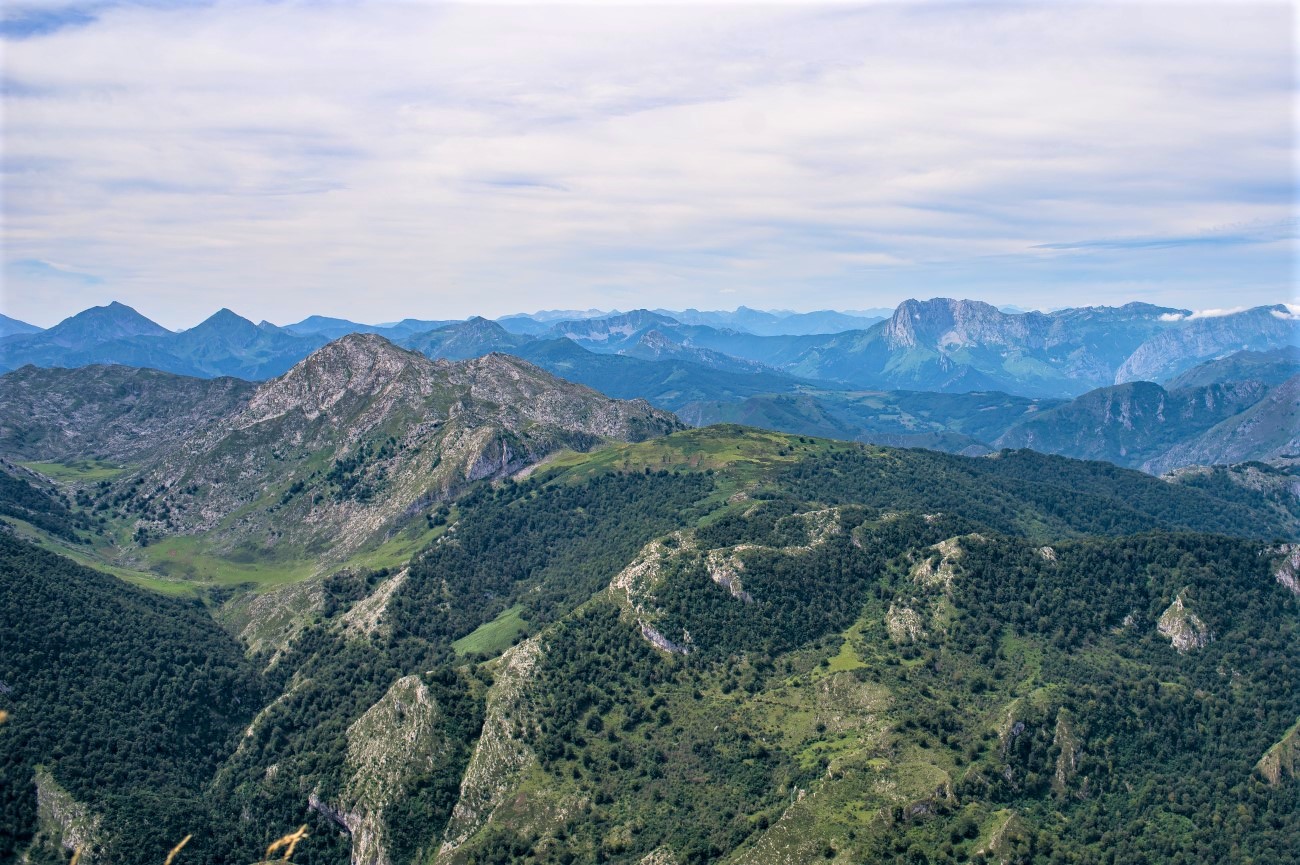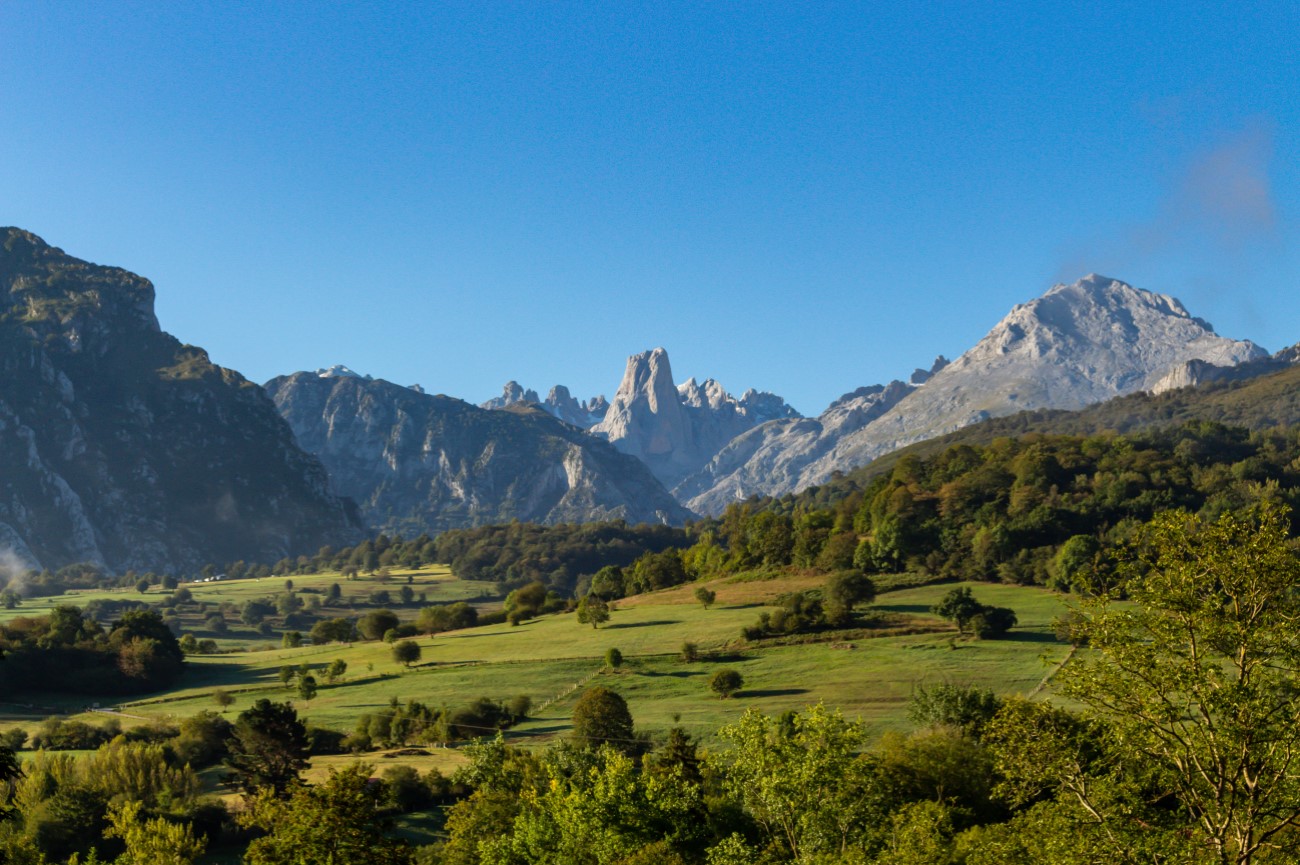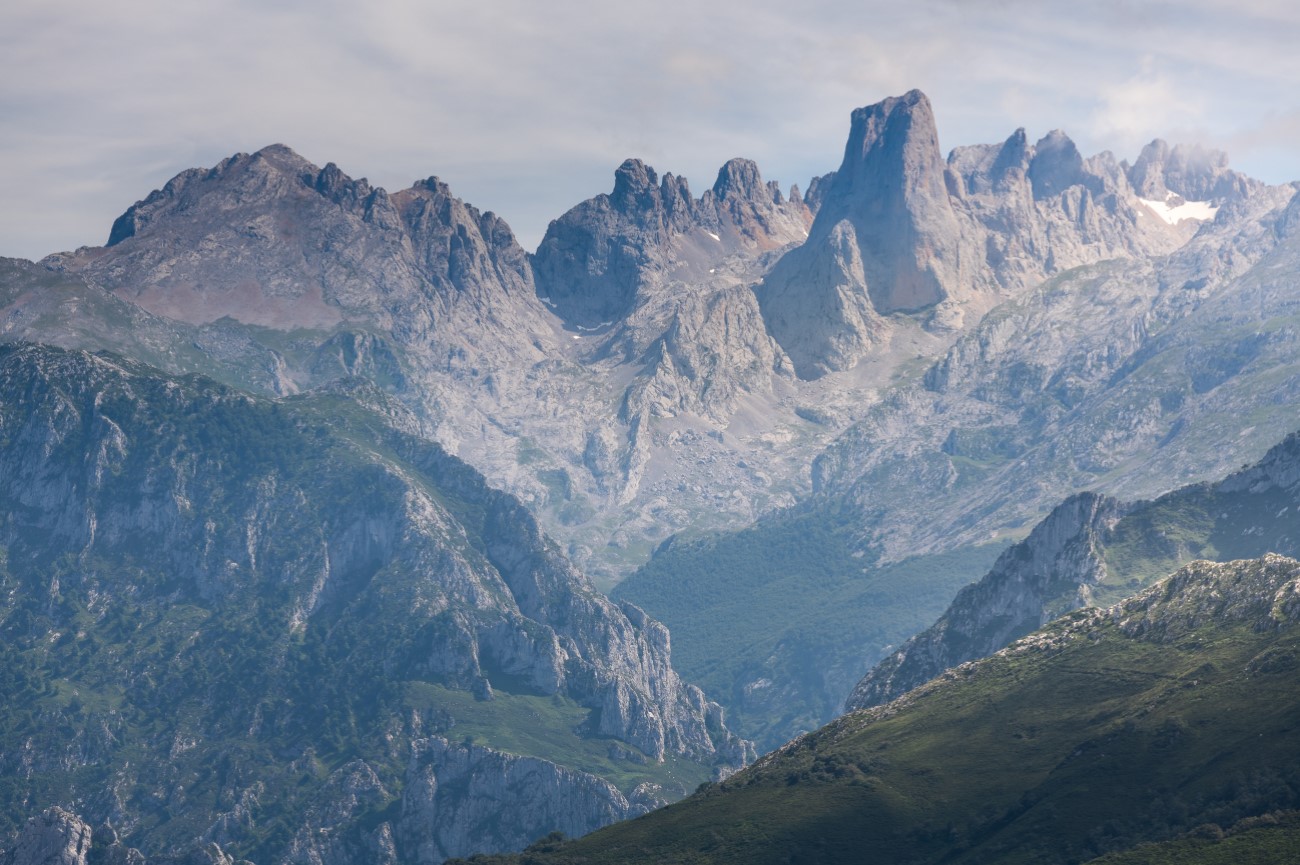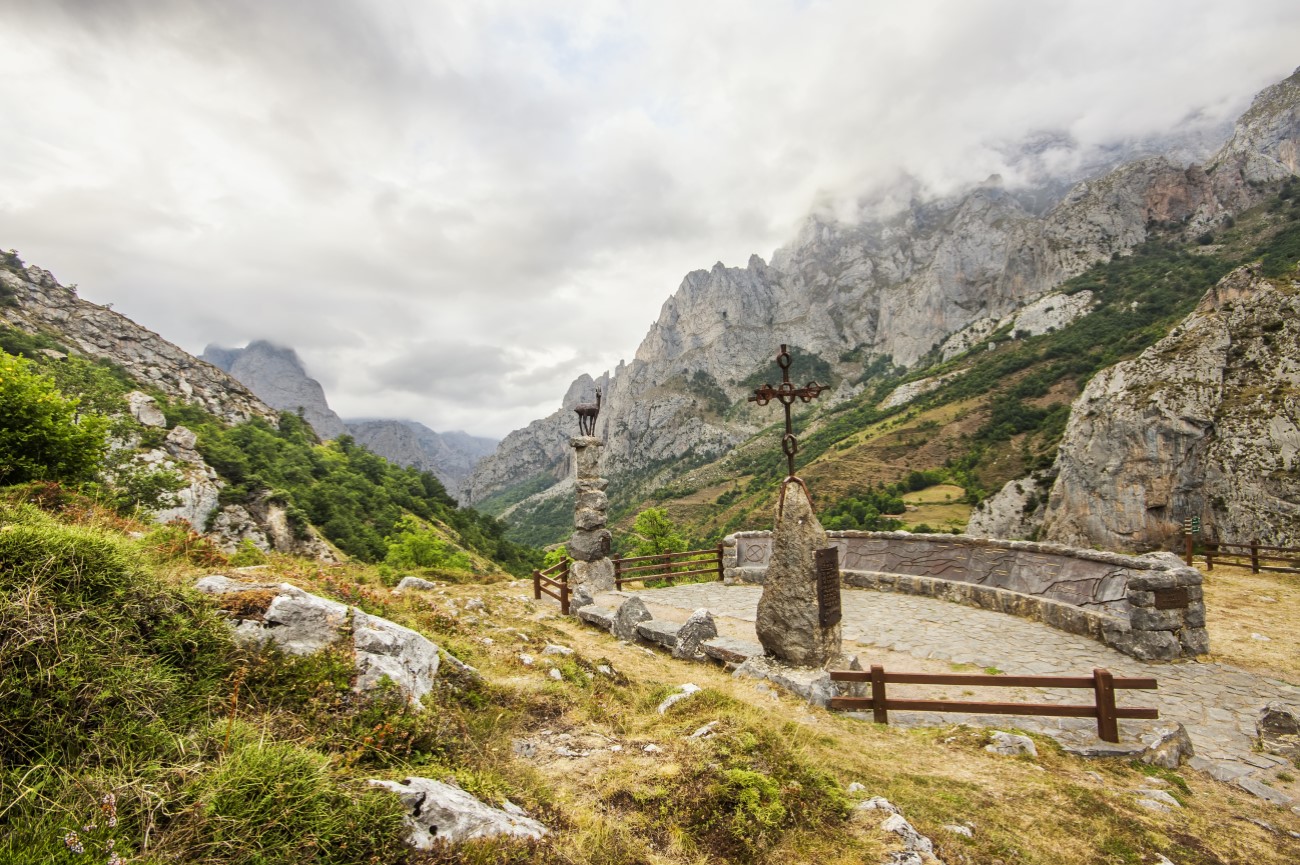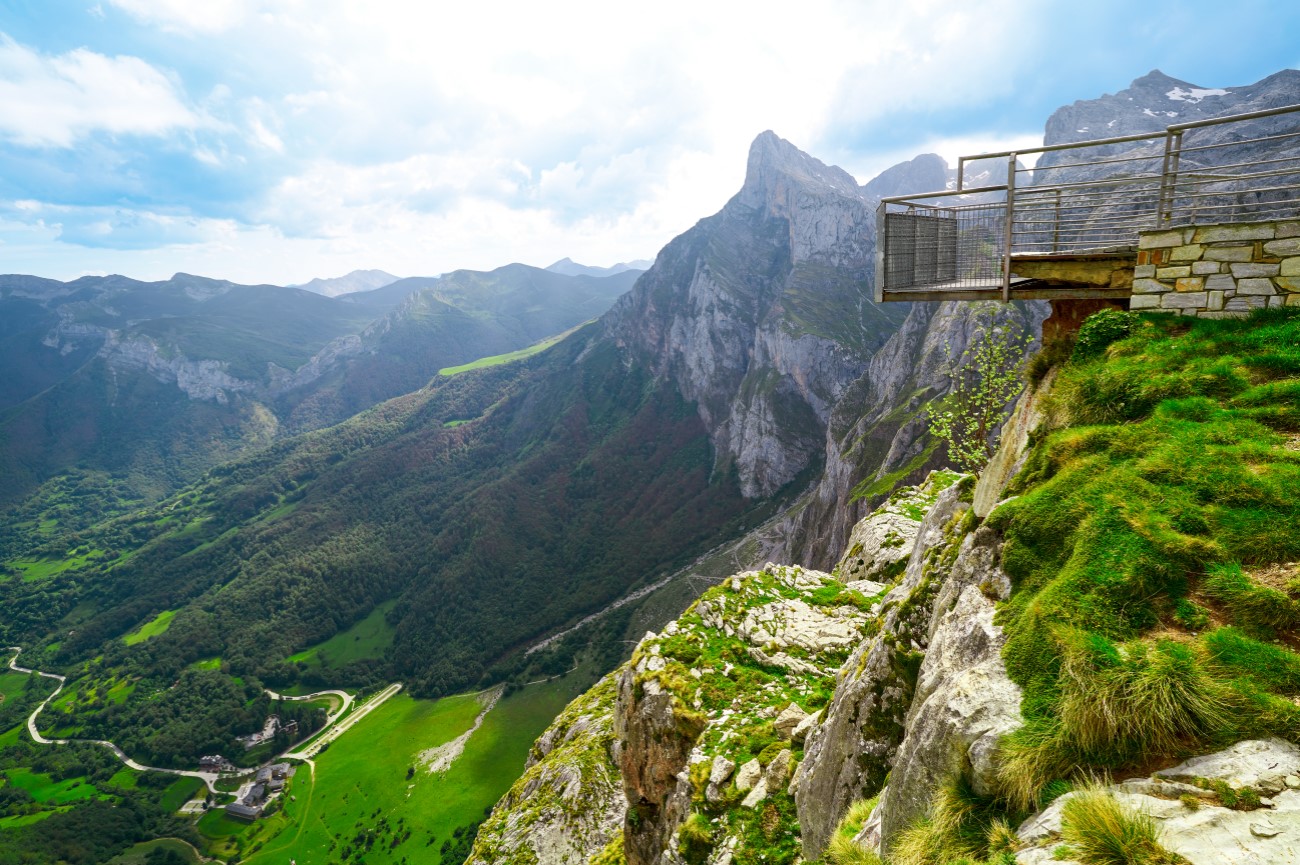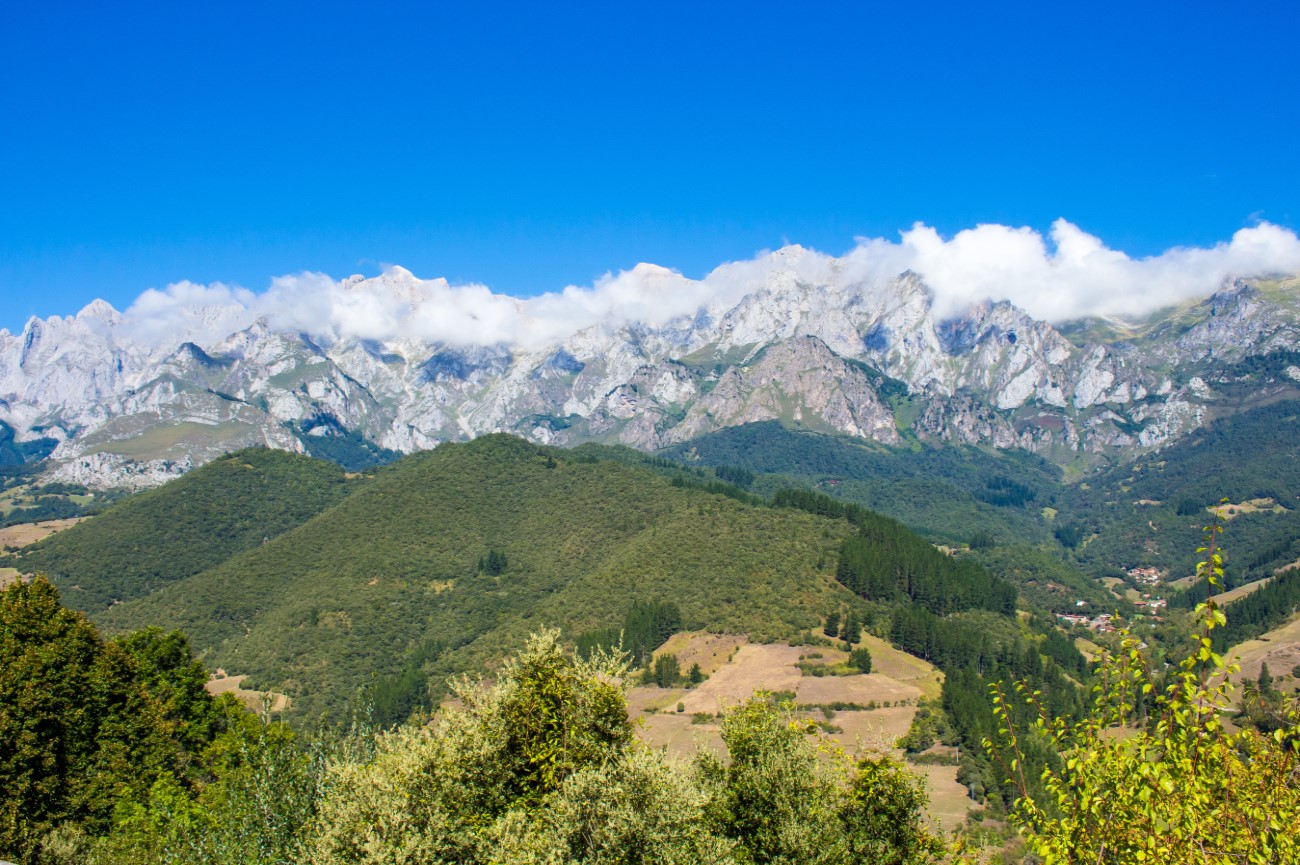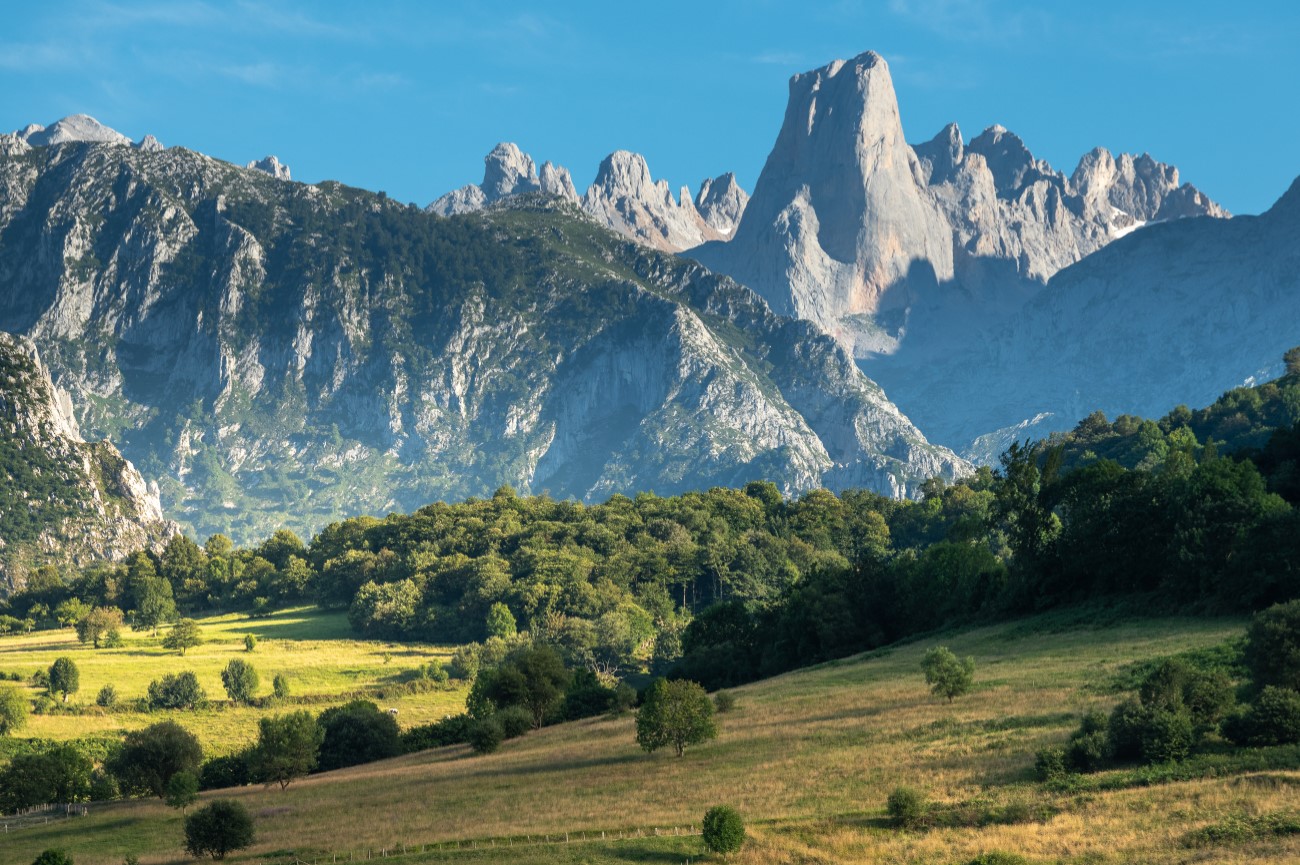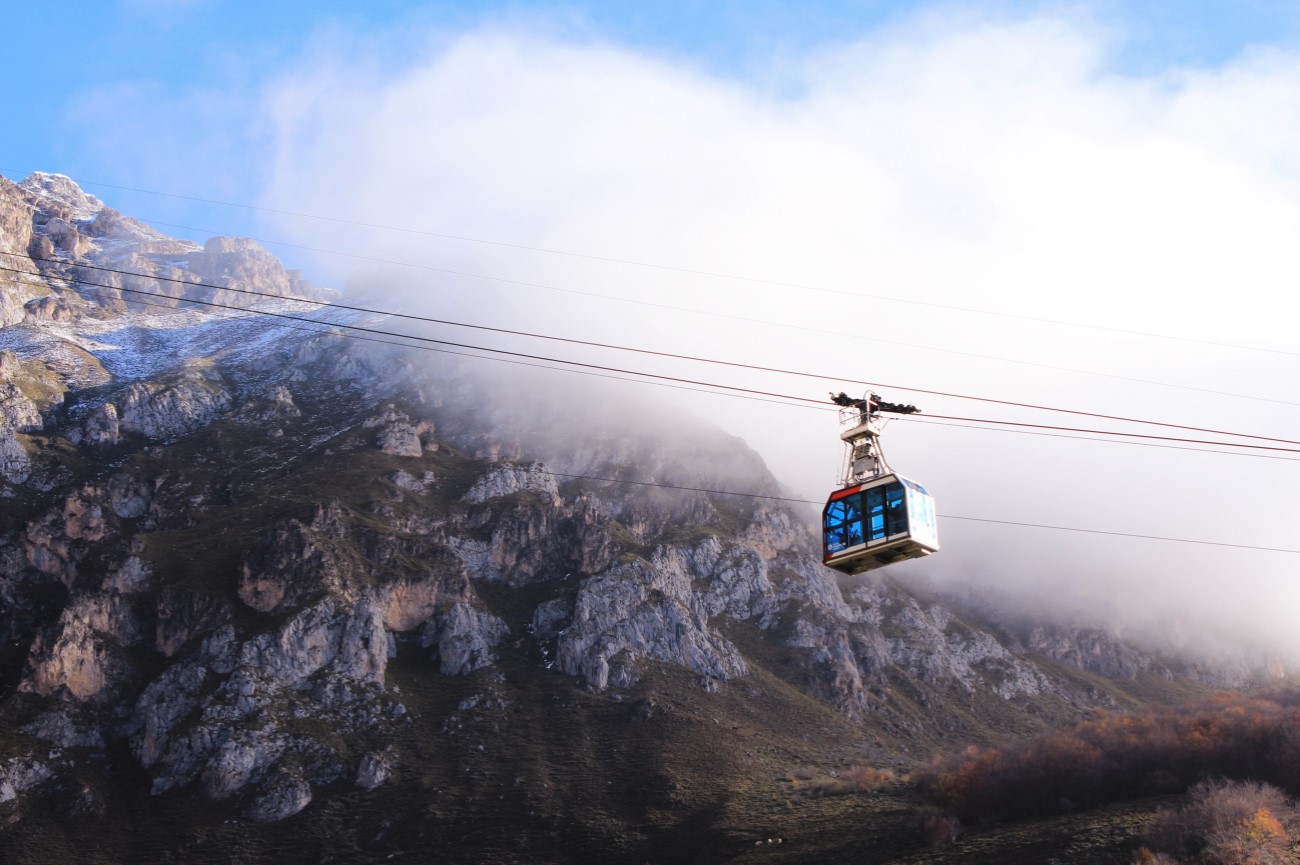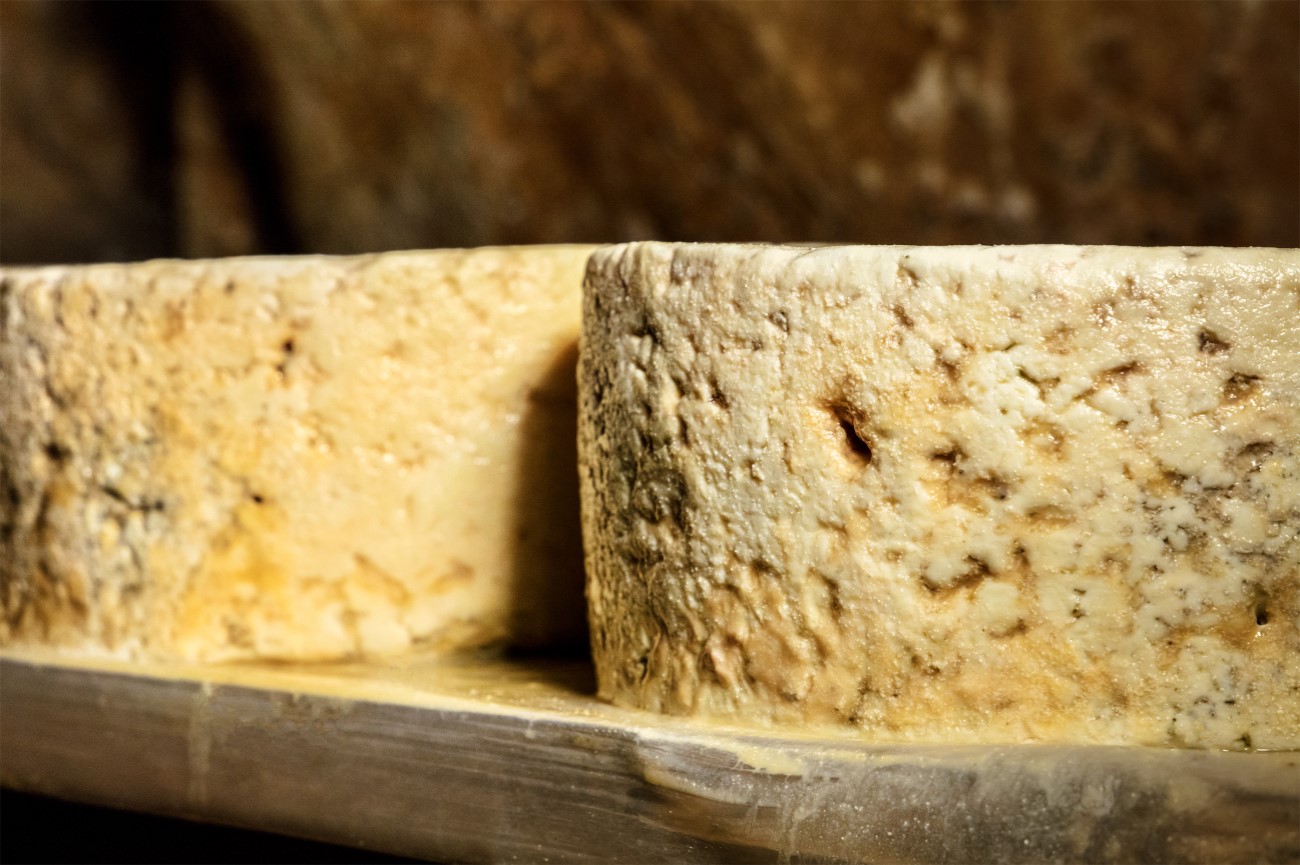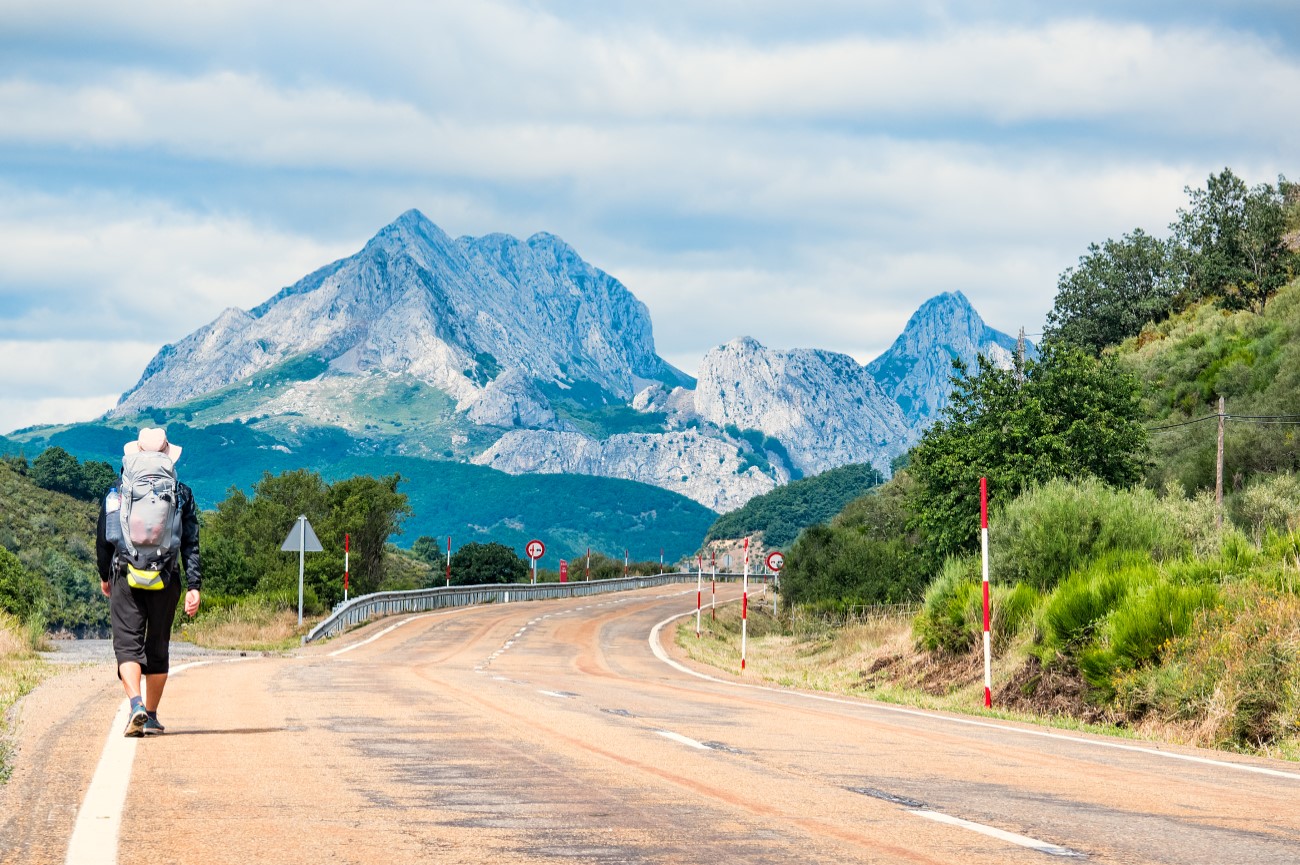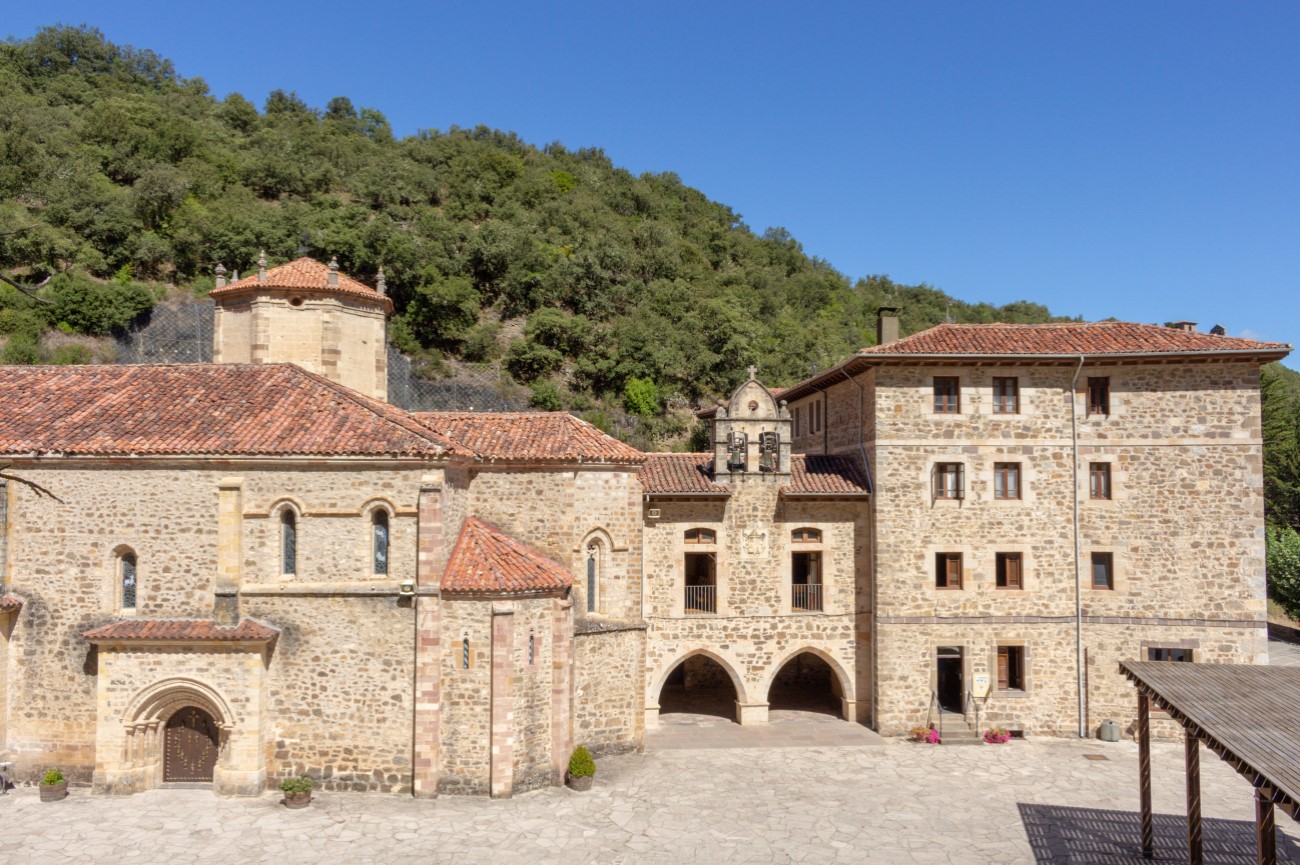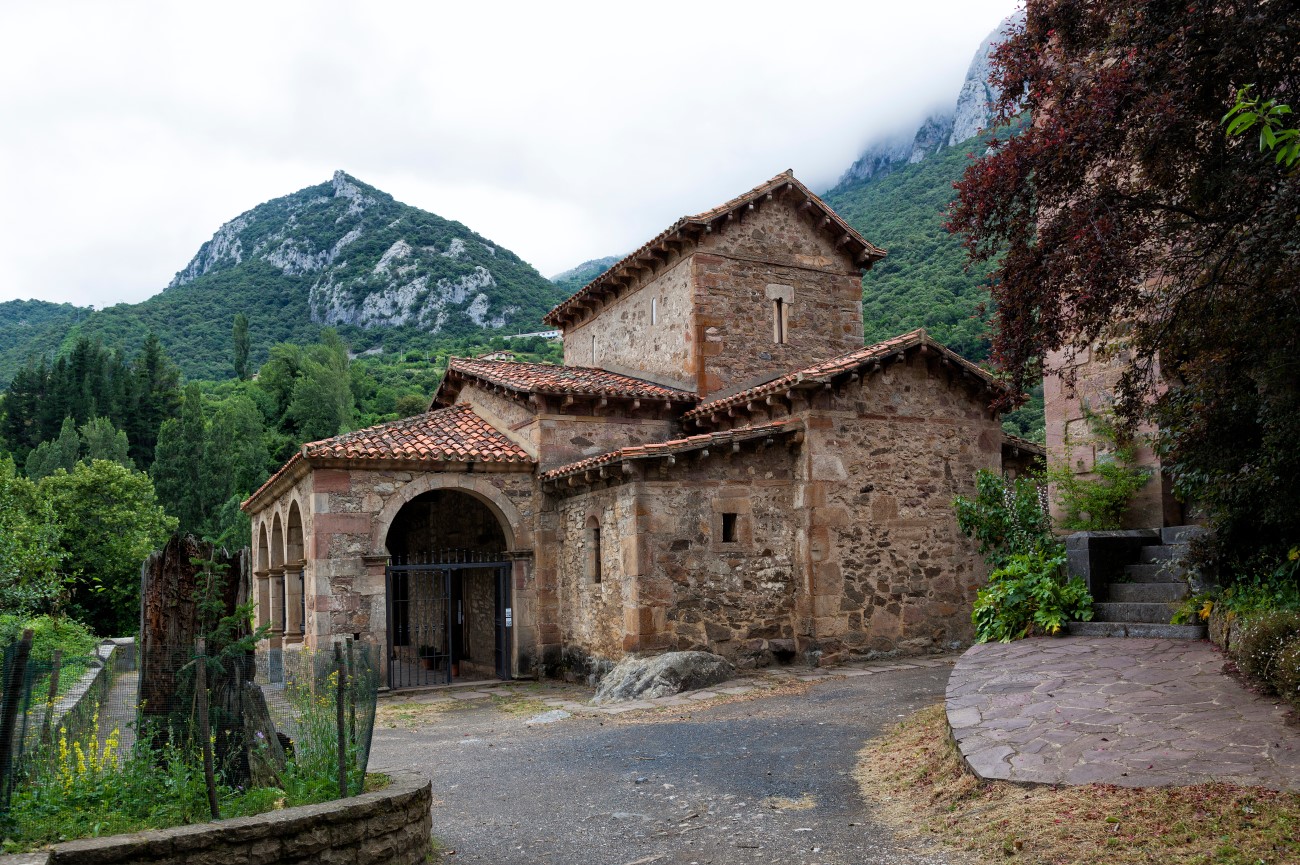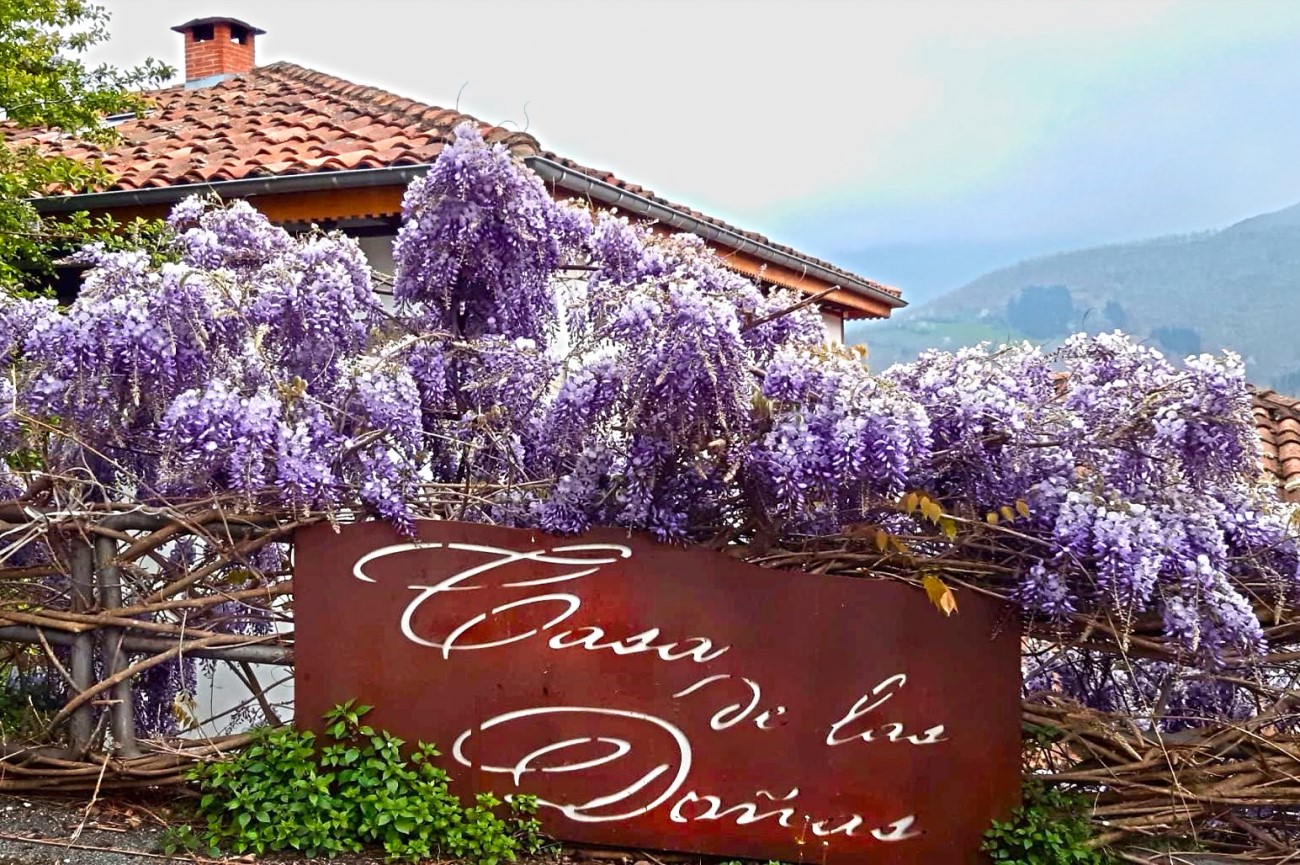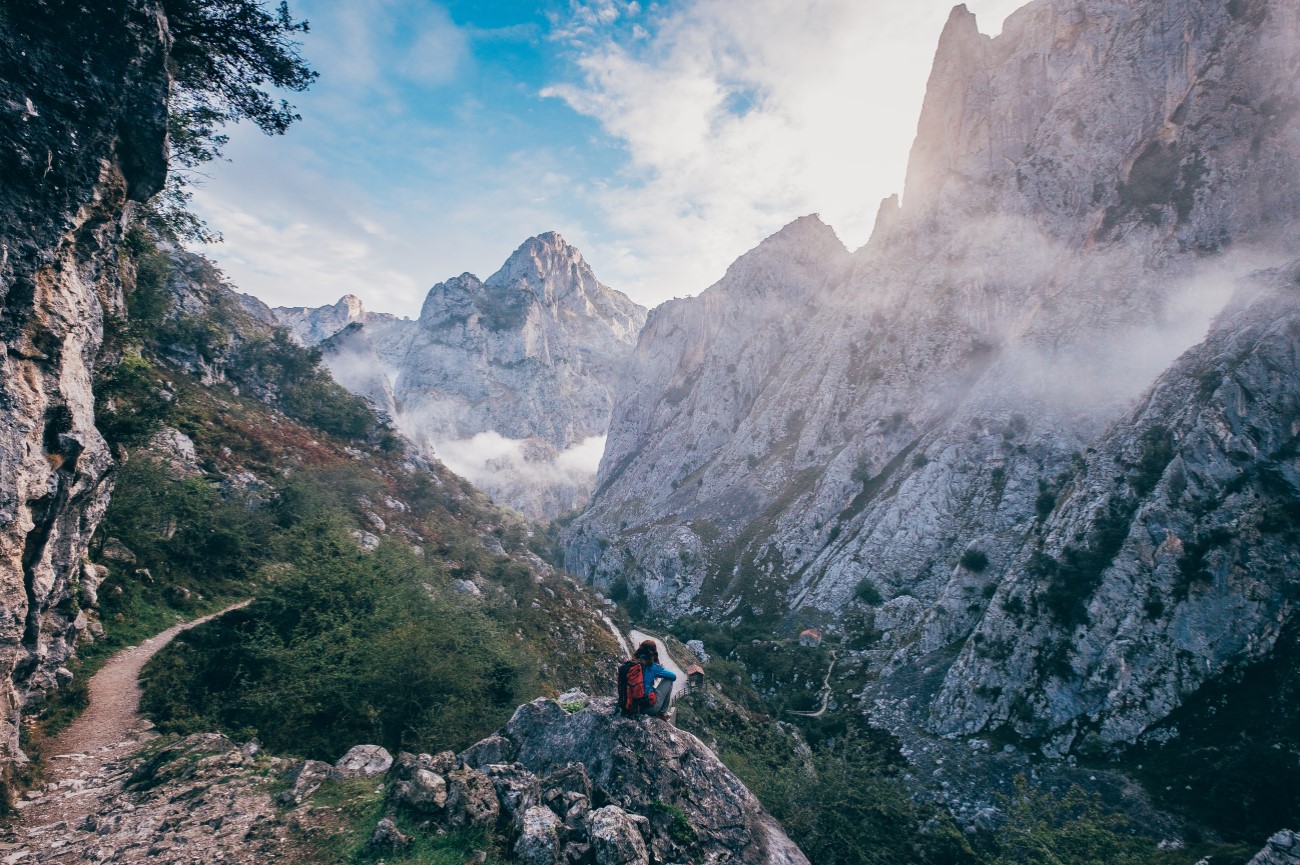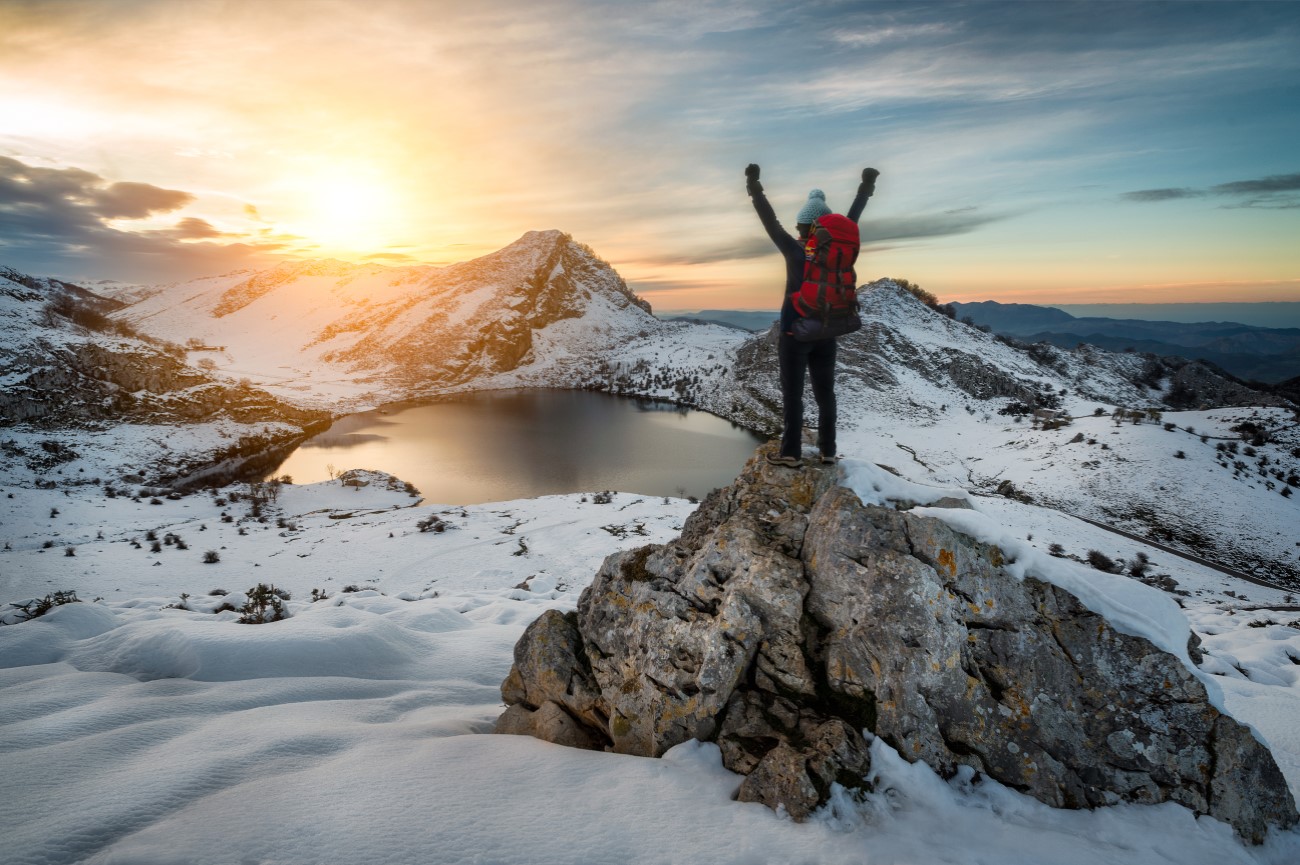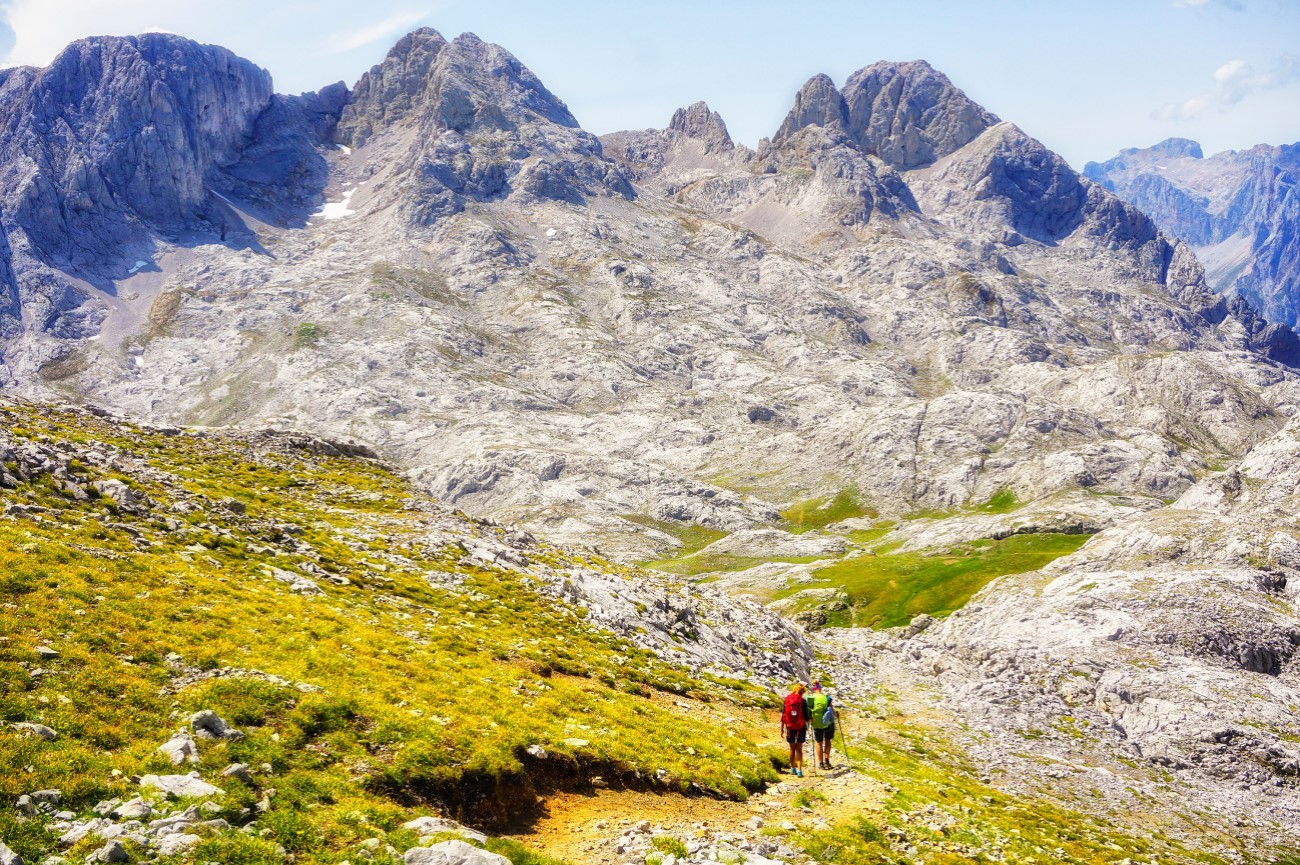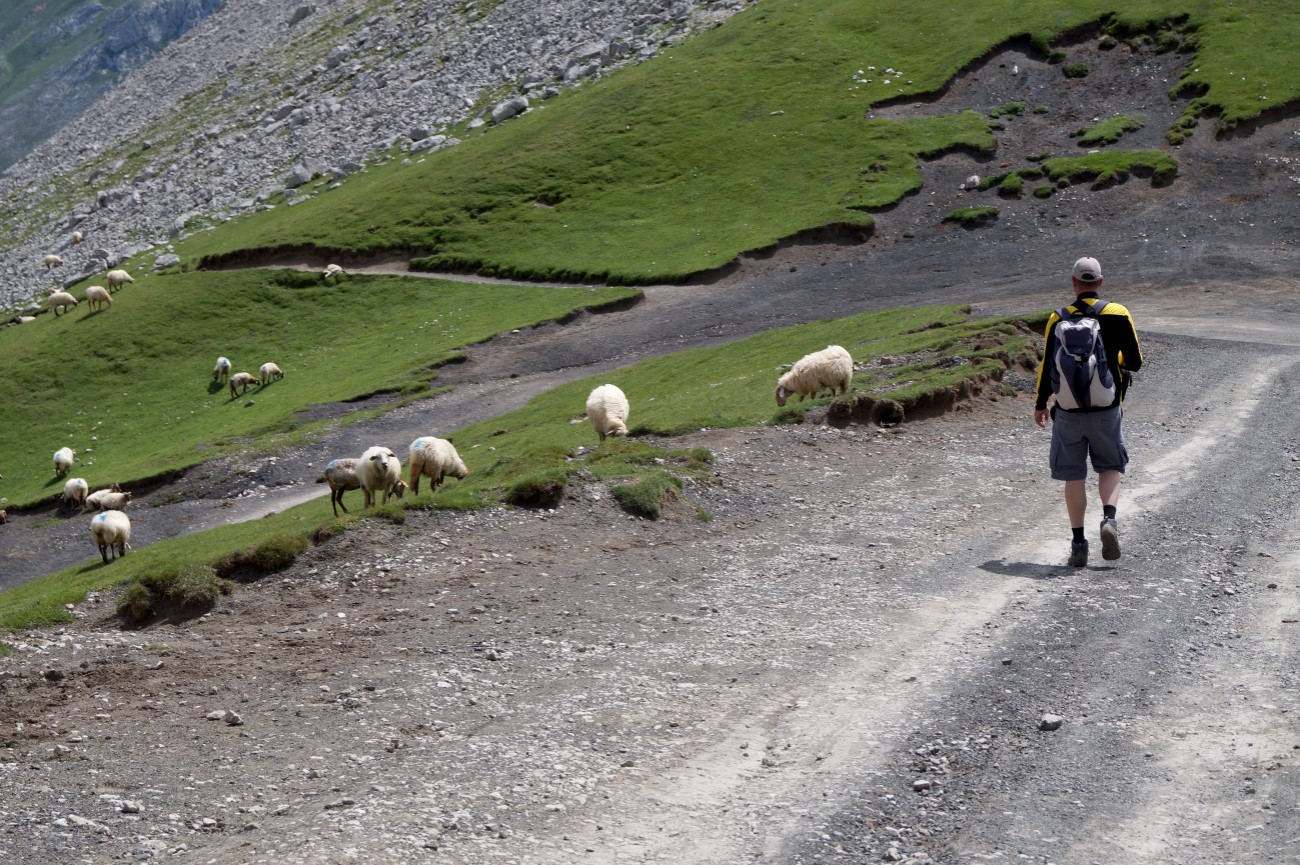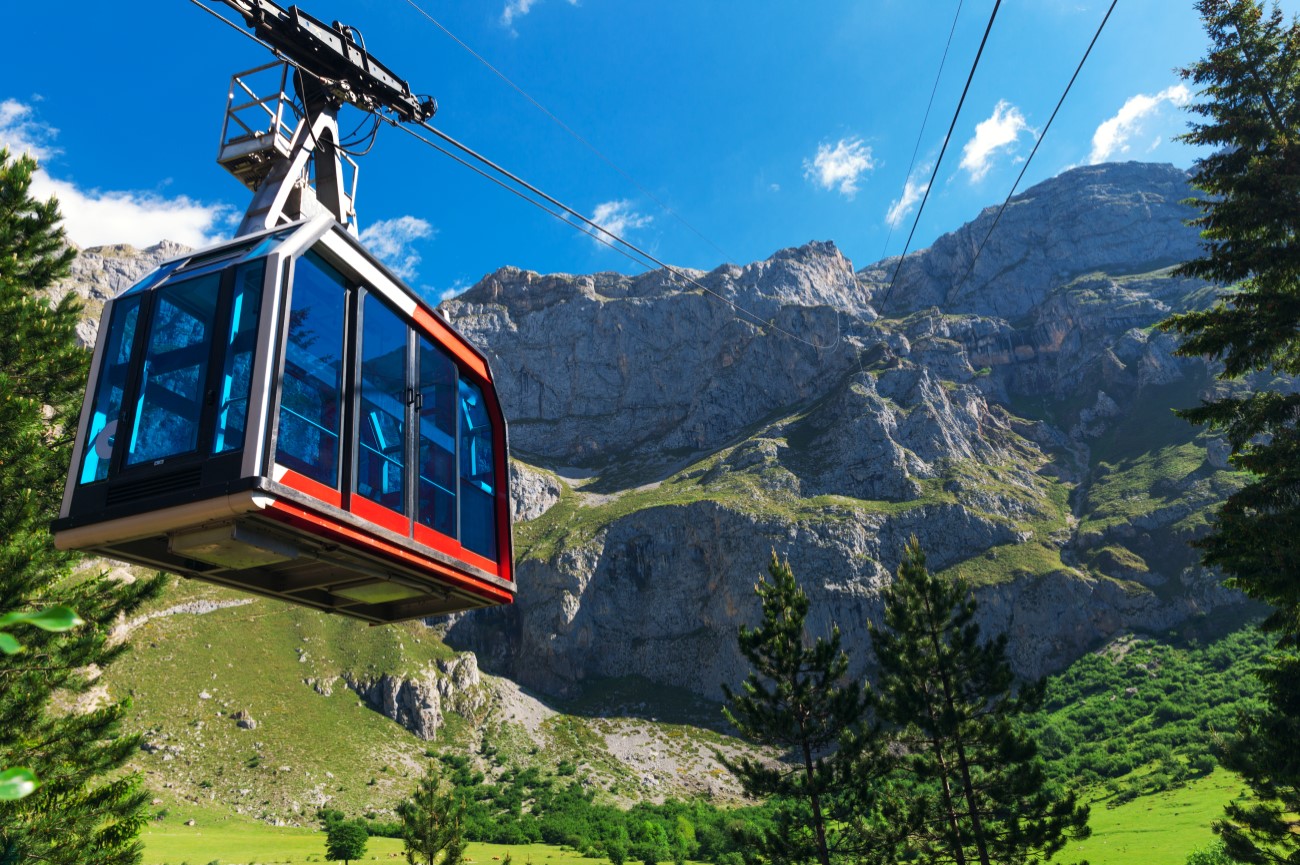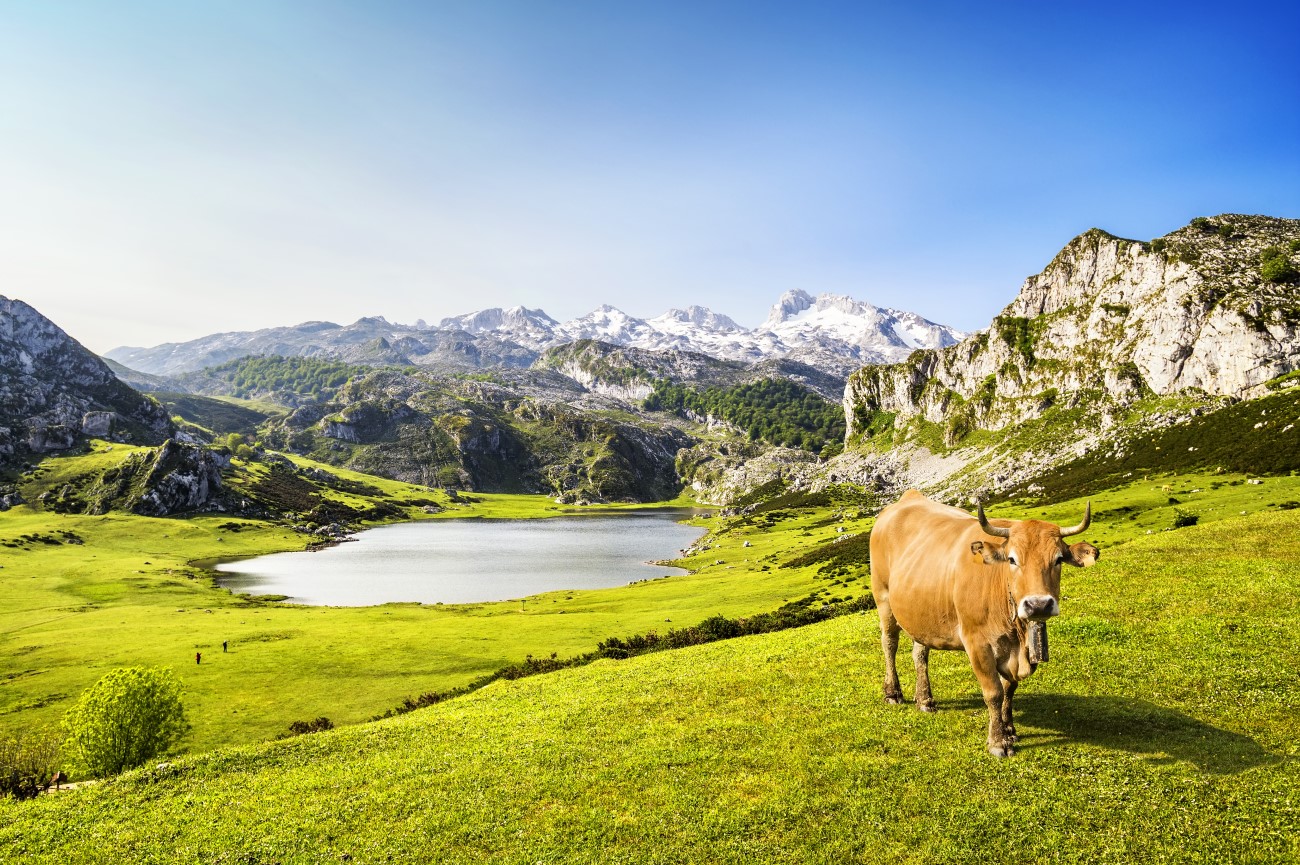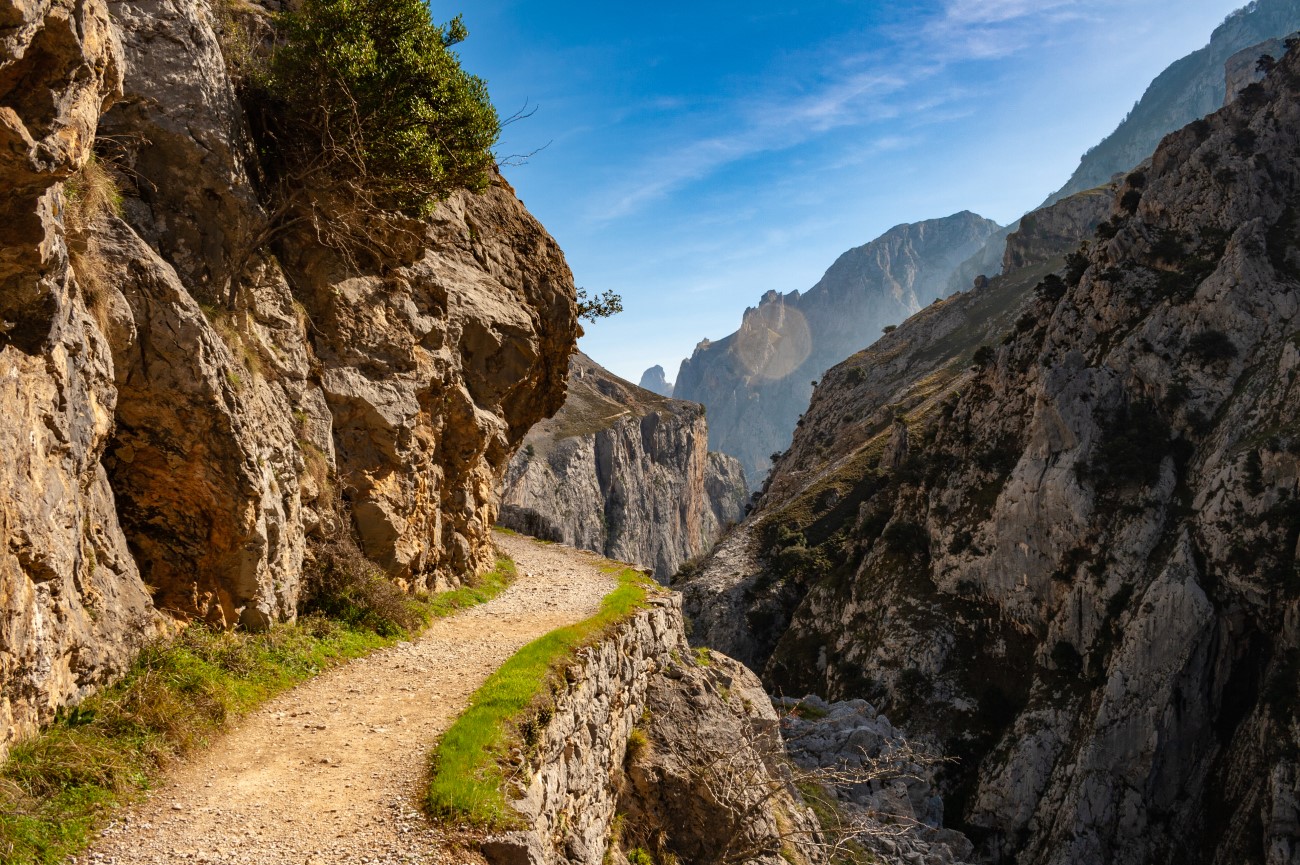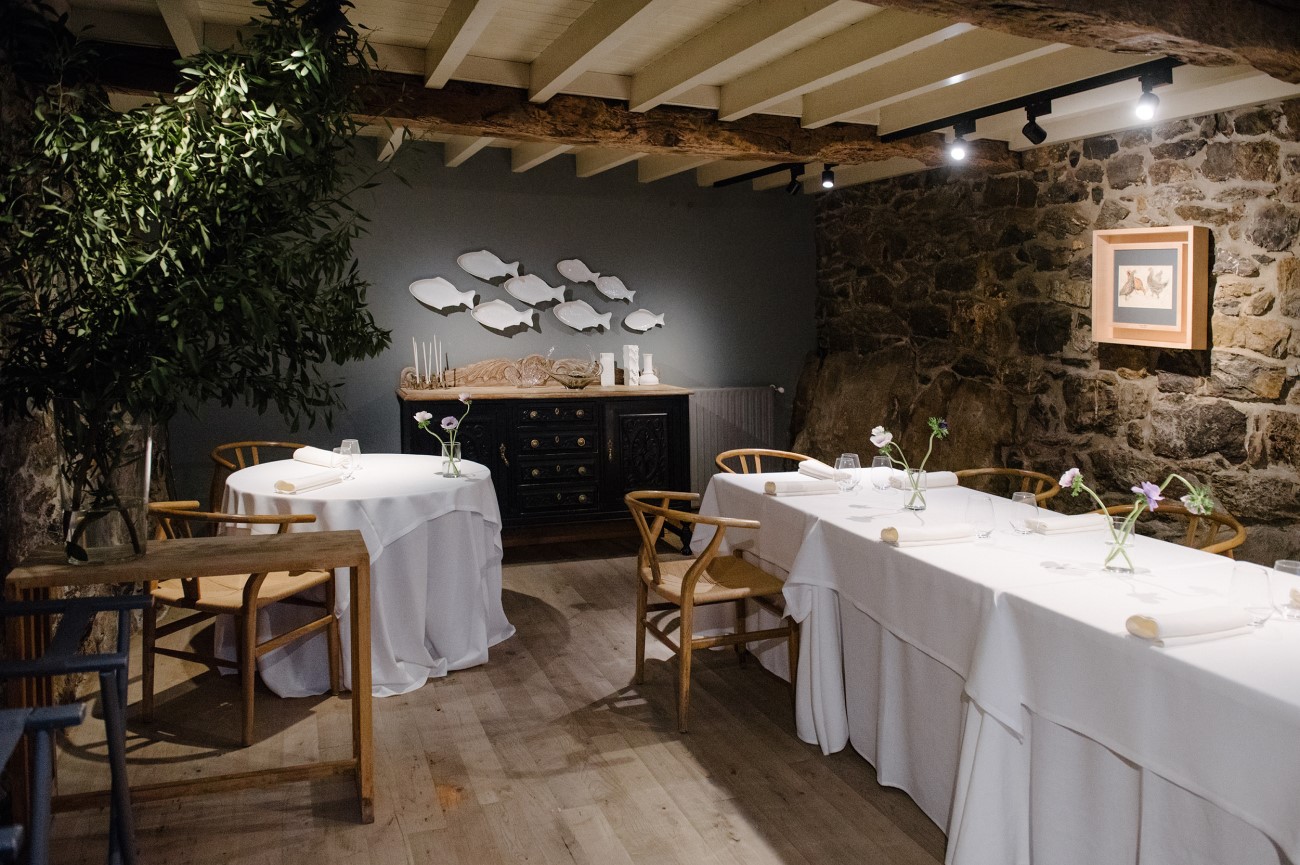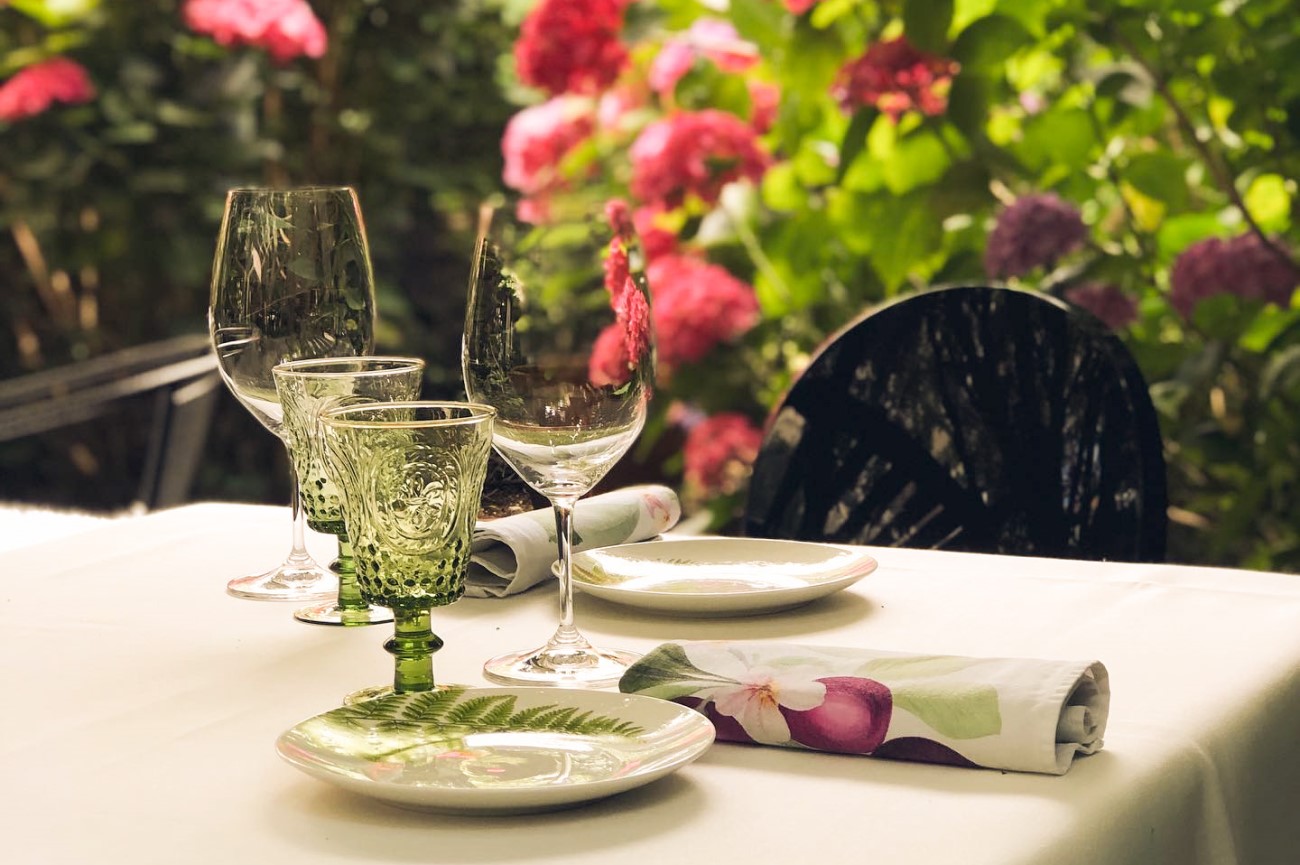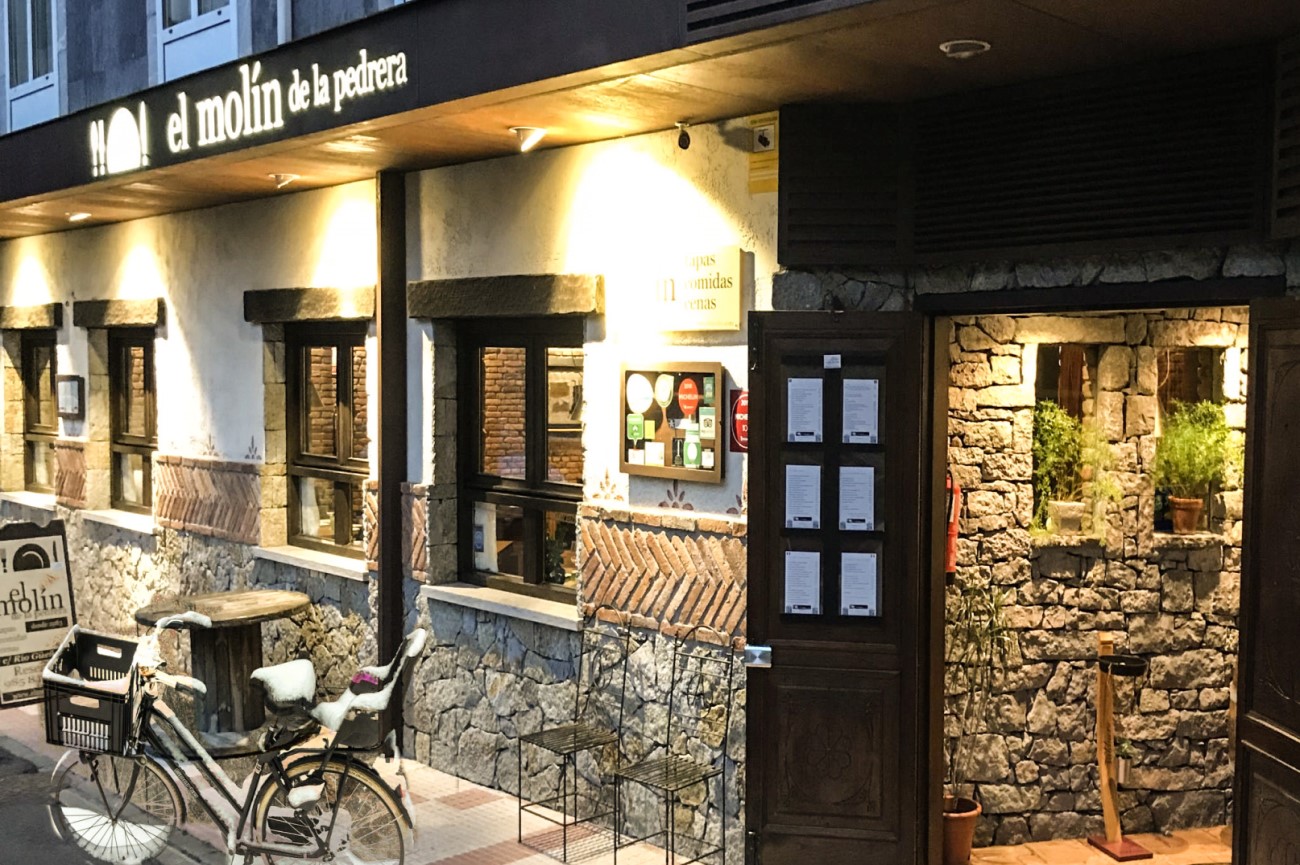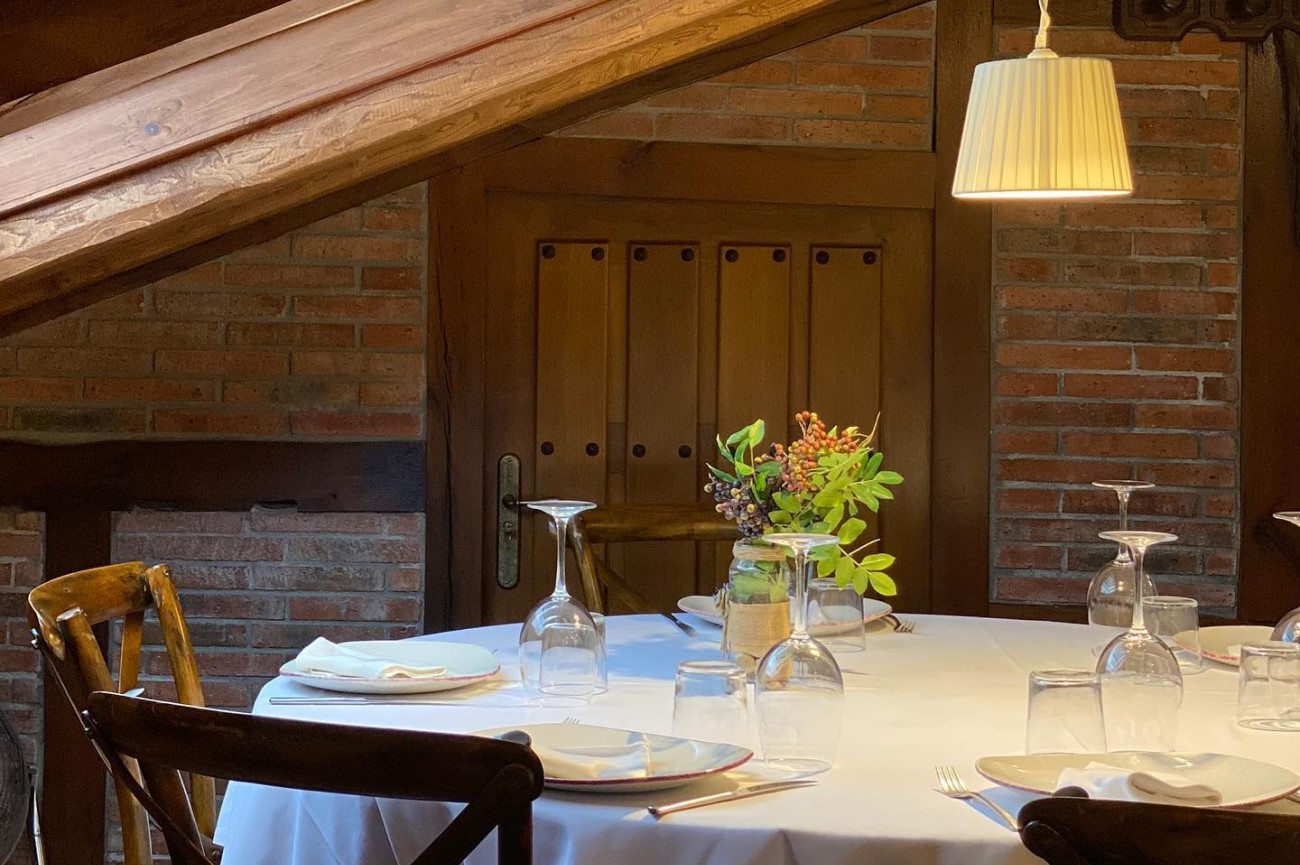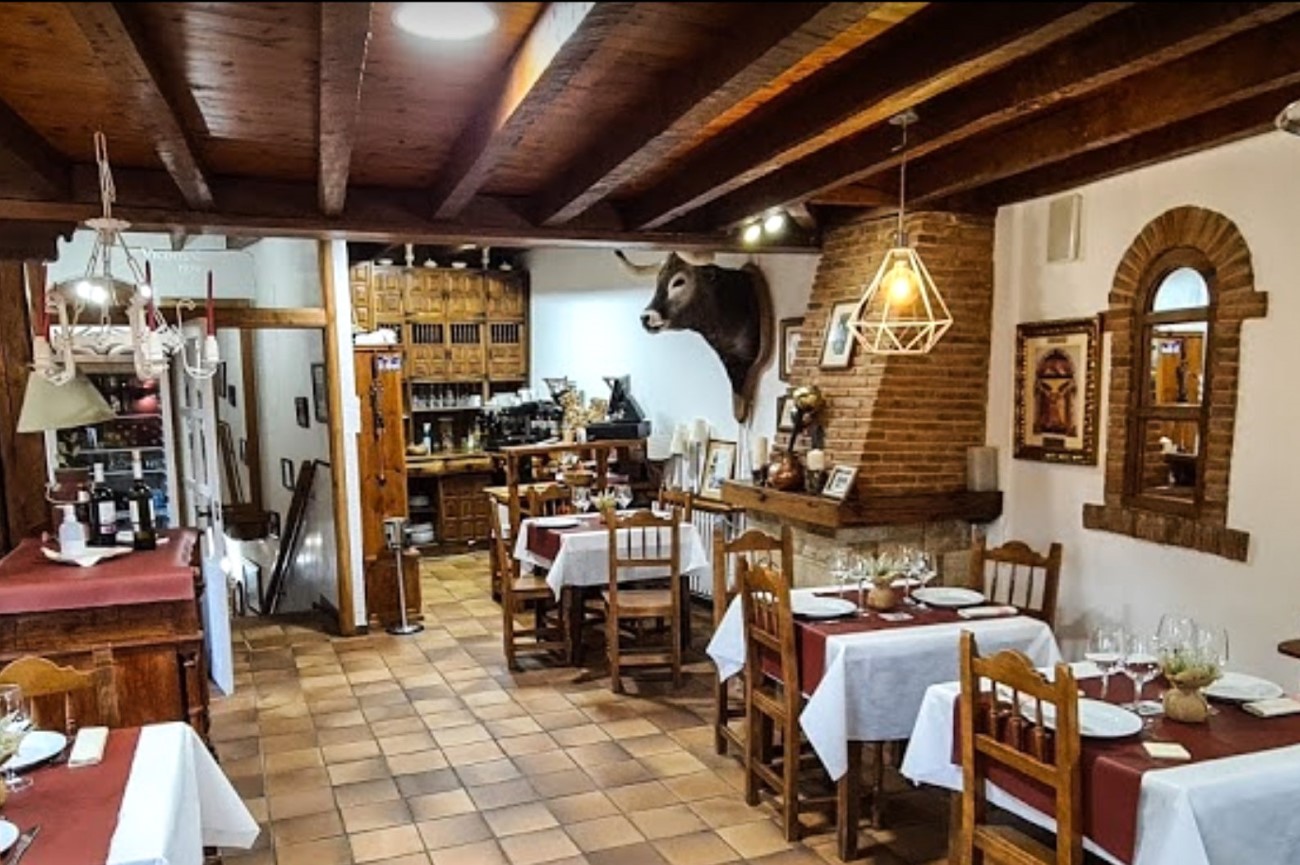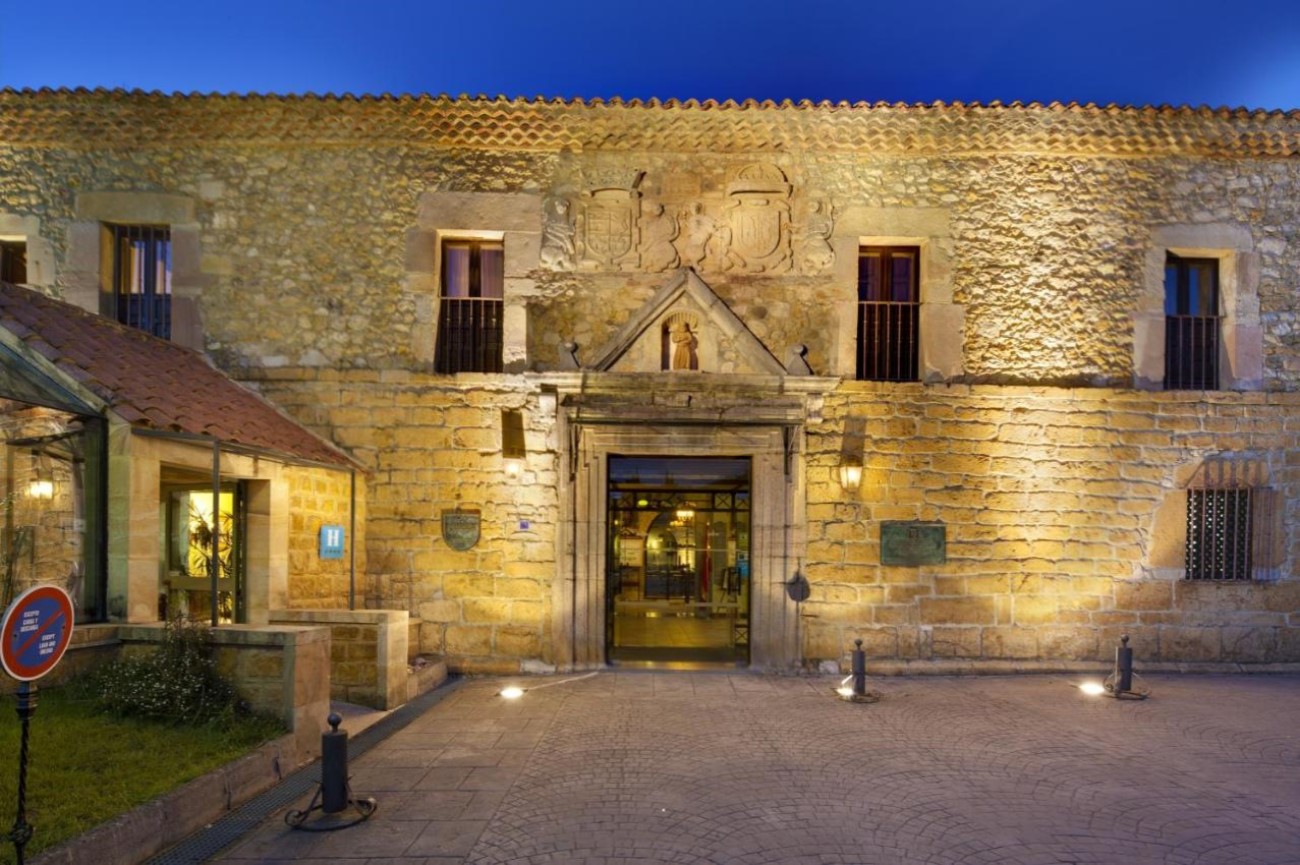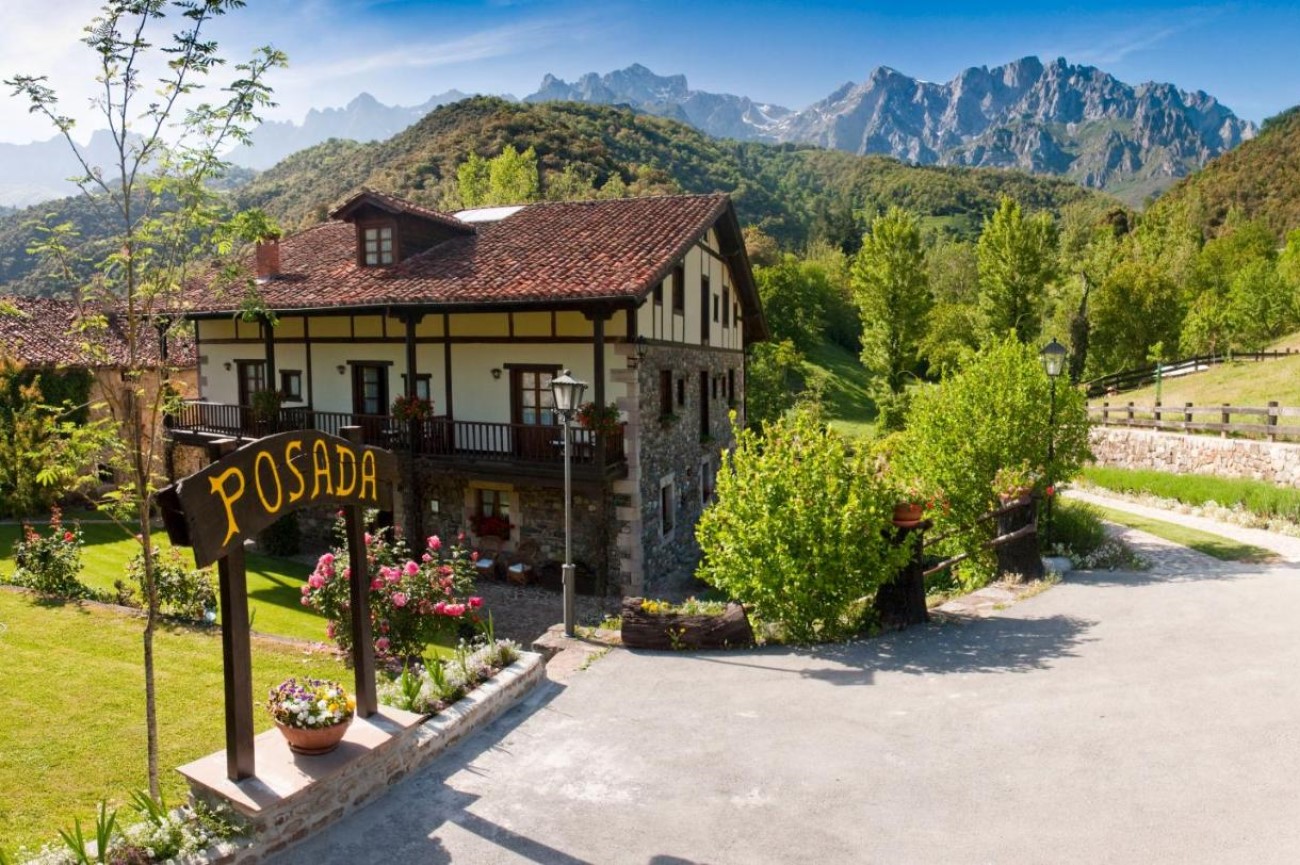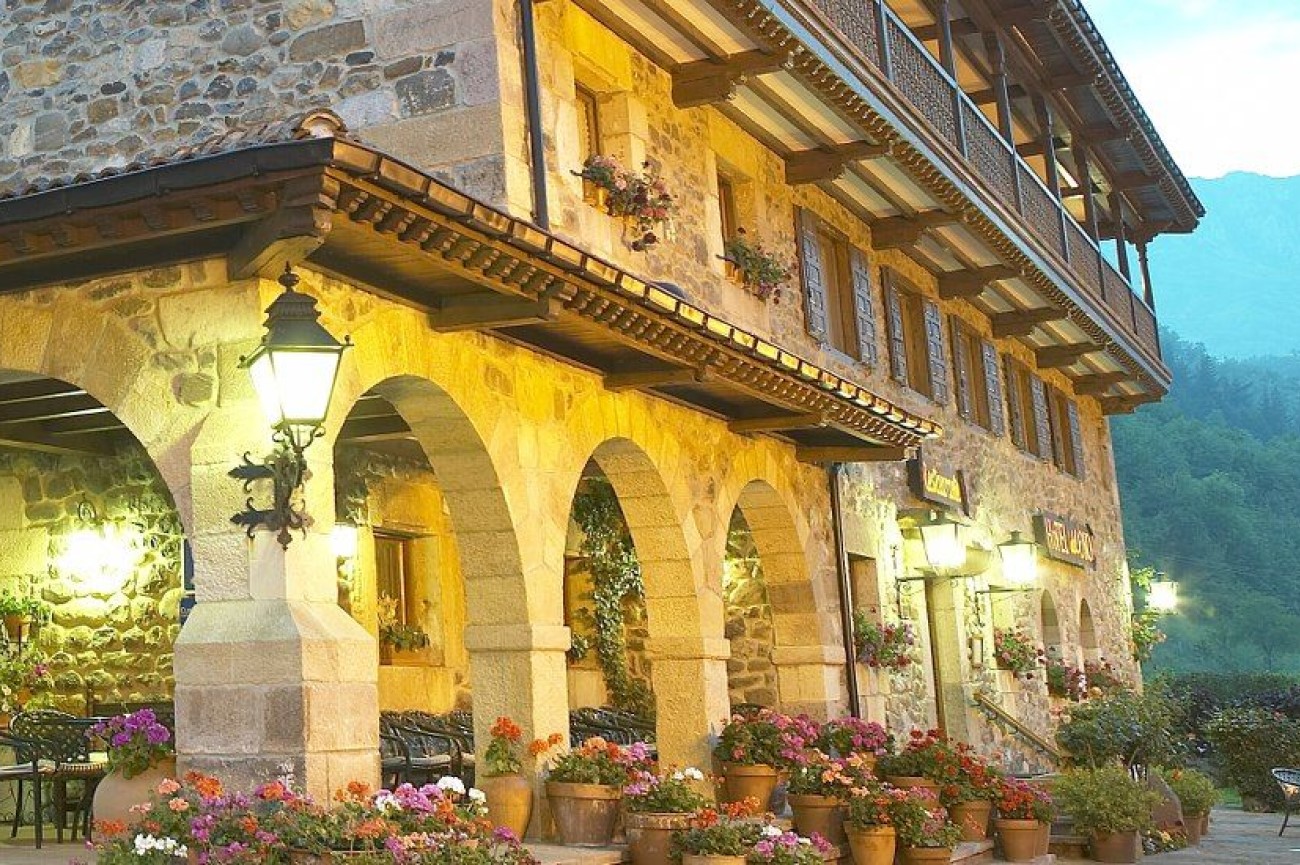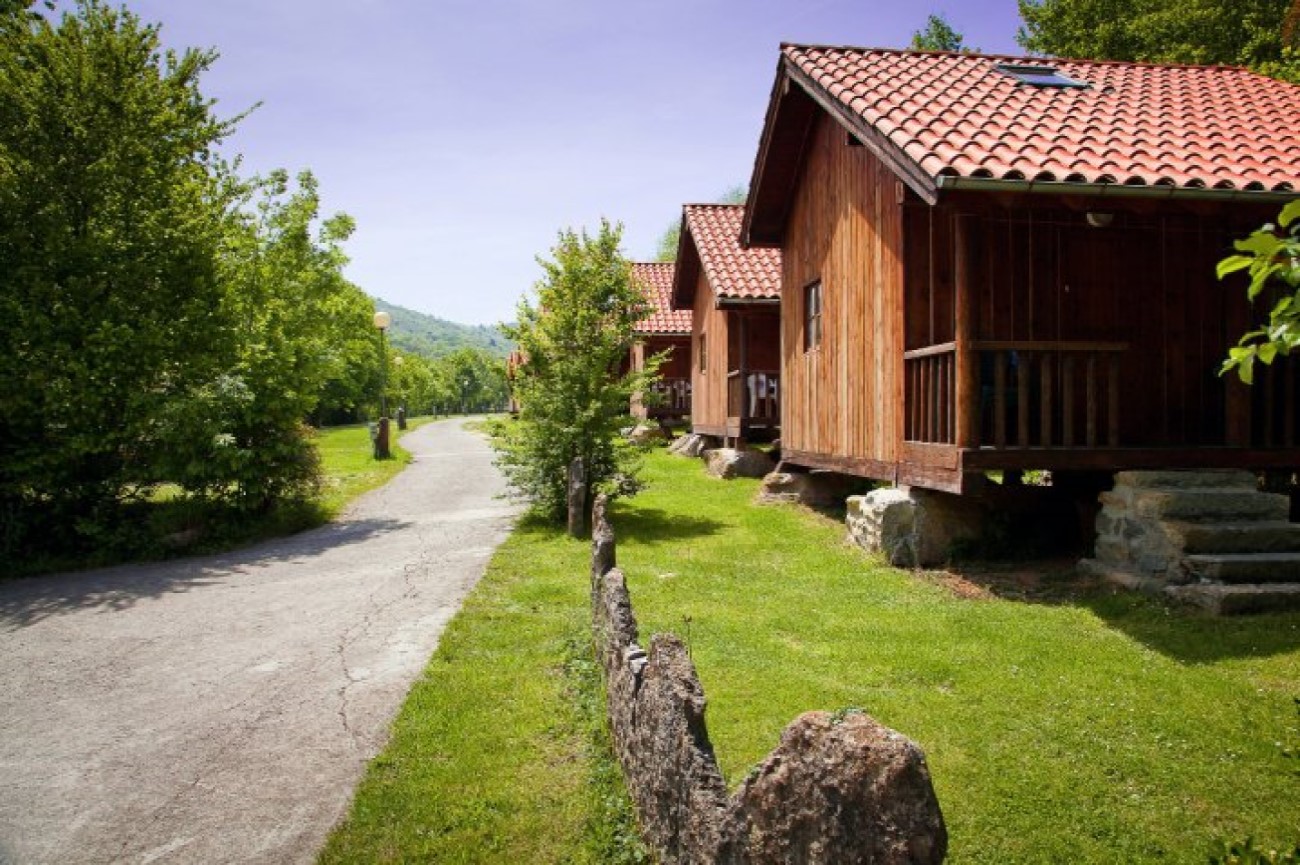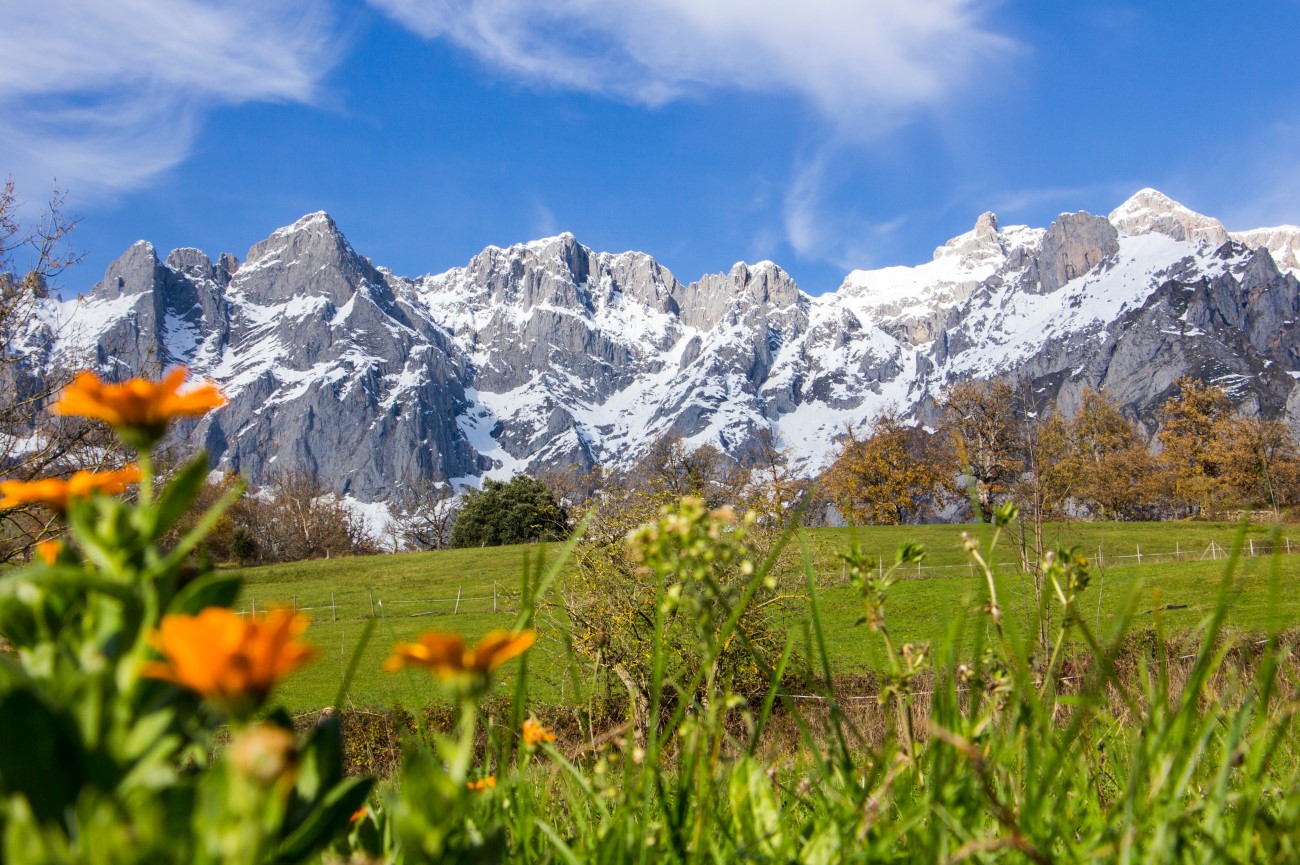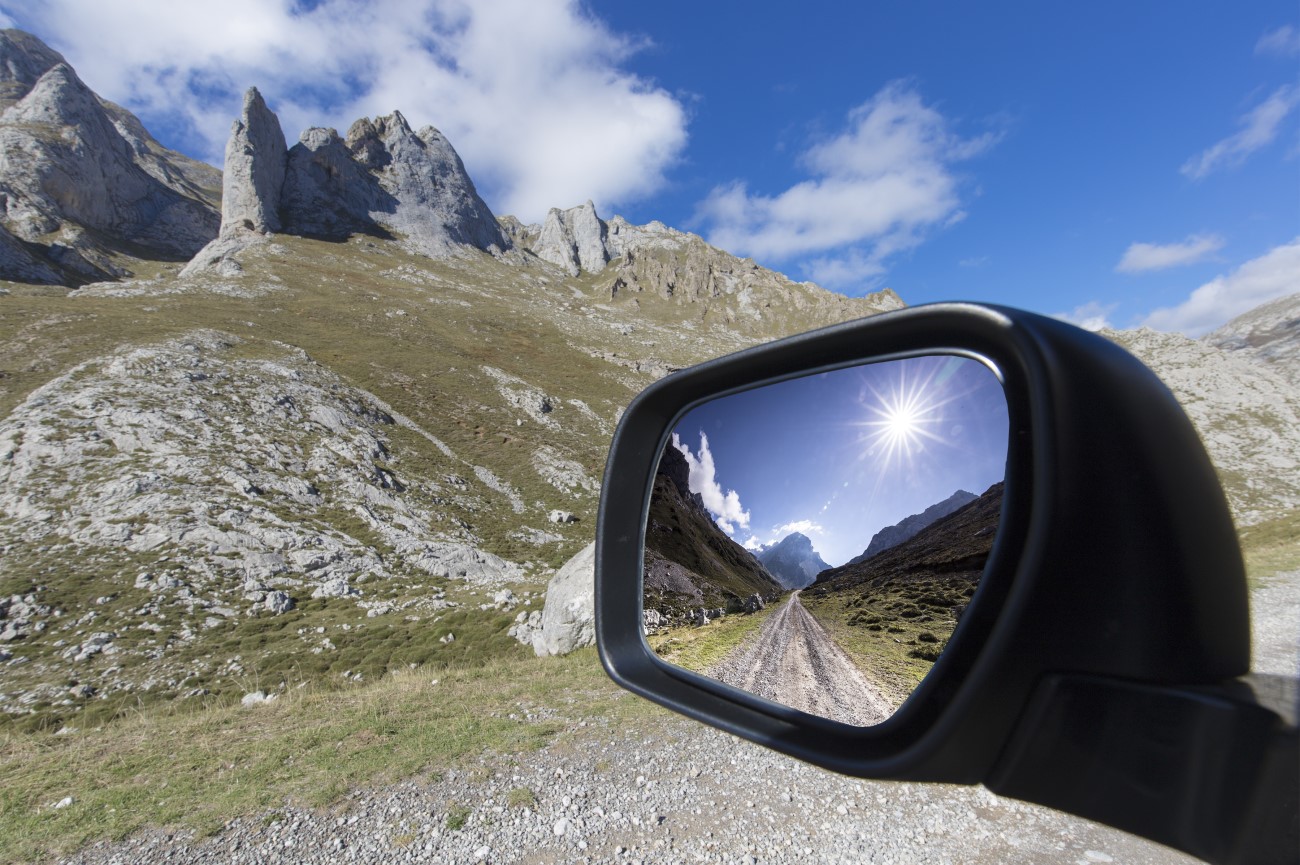Picos de Europa National Park Guide
Part of the Cantabrian Mountains, Picos de Europa is an extensive mountain range that stretches for about 20km in northern Spain. These peaks, located in Asturias, extend from Cantabria and go all the way to the region of Castilla y León. The area is famous for its natural beauty and hiking trails.
The Picos is Spain’s second-largest national park, and its highest peak sits at an elevation of 2650 m—known as Torre de Cerredo.
It features three major massifs: Central (also known as Urrieles), Eastern (known as Ándara) and Western (called Picos de Cornión). Inside the park, you’ll also find some of the world’s deepest caves and charming hilltop villages.
Our guide below includes the best things to do in Picos de Europa, so you don’t miss a thing. It features an itinerary through the region’s villages and highlights the best hiking trails, including family-friendly options.
Villages in Picos de Europa

Mogrovejo
Our tour begins at Mogrovejo, a village in the Cantabria region. Despite its small size, with only forty residents, this is one of the most picturesque villages in Picos de Europa. Most of the houses go back to the 16th-century and still stand to this day. One century later, the village’s church was erected, and it has been illuminated ever since. This village is 10km west of Potes, the next town on our itinerary.
Potes
Potes is one of the most popular villages in Picos de Europa—if not the most popular. This old town is considered the capital of Liébana, the valley area that lies between the Picos and the Cordillera Cantábrica.
In Potes, you can feel a medieval vibe, reinforced by some of its famous sights. San Cayetano bridge and Torre del Infantado are two great examples of this era.
Since this village is an important staging post, it’s better equipped and prepared for tourists than others. Proof of this is the interactive exhibitions inside some of the houses, telling you a bit about Potes’ history—particularly the story of Beato de Liébana, a well-known theologian and monk.
Sotres
Sotres sits in the Asturian municipality of Cabrales, and it’s the highest village in Picos de Europa. It’s part of the area’s Biosphere Reserve, surrounded by the peaks of the Central and the Ándara Massif. Around a hundred people live here, but during the summer the town is much more crowded with tourists occupying the available hostels. The population of Sotres has decreased since the early 1970s, but the recent opening of the park’s first ski resort has helped attract more visitors.
Bulnes
Bulnes may be the most challenging village to get to. Sitting very high in the mountains with rocky peaks surrounding it, it’s not accessible by road, which means you have to arrive on foot. You can follow the very much inclined 5km trail, starting in Poncebos—which takes about two hours. Another option is to hop on the Funicular de Bulnes, a tunnel railway that rises for about 2km, leaving you at the village. Bulnes is divided into two areas: Barrio del Castillo, at the highest point, and La Villa, at the lowest, where you’ll find all the amenities.
Arenas de Cabrales
Arenas de Cabrales is popularly known as Las Arenas. It’s one of the most populated villages in the region, with its main road packed with restaurants, hotels and bars. The village is a famous base for walking the Garganta del Cares, a spectacular trail that crosses the mountains.
Covadonga
To the west of Las Arenas is Covadonga. This small village was an important site during the Reconquista—when the Muslims were defeated for the first time in Spain, around 722 AD. Covadonga offers incredible mountain views and it's surrounded by forests, creating a magical setting whenever it snows. Rising amid the mountains is the imposing 19th-century basilica.
It’s also worth checking the lakes close to the village: Lago de Enol and Lago de la Ercina (1km away from each other).
Don’t miss the Mirador de la Reina—a stunning viewpoint overlooking the Bay of Biscay 8km uphill from Covadonga. To learn more about the village’s history you can visit the Museo de Covadonga.
Arriondas
If you’re a fan of kayak or canoe trips, then Arriondas has to be on your list. This tiny village is home to the Río Sella, a lake that has several endpoints between Toraño and Llovio. Despite its size, Arriondas is filled with hundreds of people on the first Saturday after August 2nd. This is the day of the Descenso Internacional del Sella, an international kayaking and canoeing event.
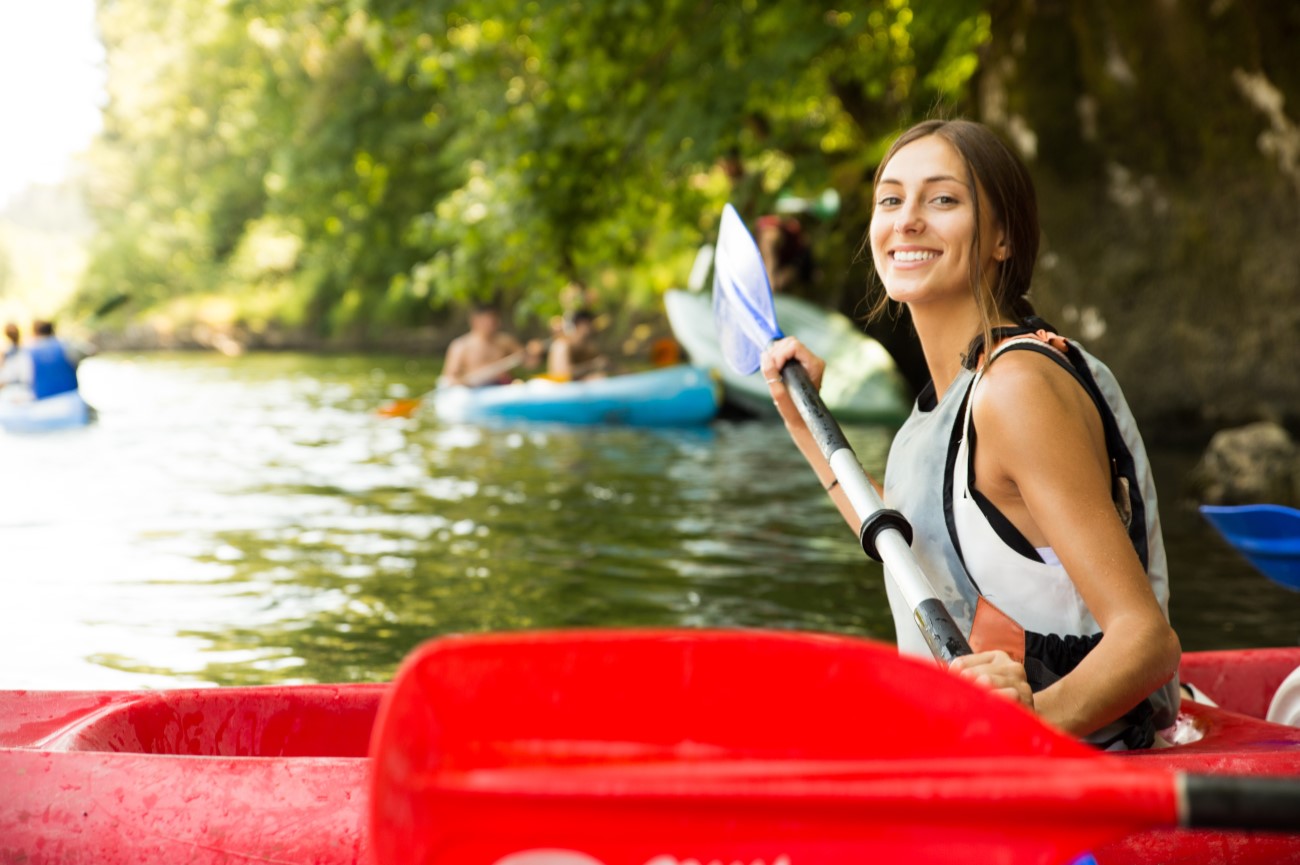 The Descenso Internacional del Sella, an international kayaking and canoeing event, Arriondas, Spain
The Descenso Internacional del Sella, an international kayaking and canoeing event, Arriondas, Spain
Cangas de Onís
Cangas de Onís is the most famous village in Picos de Europa since it’s there that most hiking trails begin. Because of this the place is filled with plenty of facilities and is way more populated than other villages. The town sits 30km west of Arenas de Cabrales and for a while it was the capital of the medieval Kingdom of Asturias. It fills up with tourists in August, but it’s still pleasant to visit.
Soto de Sajambre
Soto de Sajambre belongs to the Sajambre Valley. It’s one of the most remote villages in Picos de Europa and you can access it on foot, passing through several viewpoints along the way. Soto de Sajambre is what it is today thanks to Félix de Martino, who, after emigrating to Mexico (where he got rich), decided to invest in its birth town—improving the living conditions.
Best Viewpoints in Picos de Europa
- Mirador de la Reina: You’ll find this viewpoint on the way to the lakes of Covadonga. From here, you can spot the village of Cangas de Onís, the Cuera mountains and even a bit of the coast on a clear day. The road is usually closed during the summer, but you can reach the viewpoint if you arrive before 8:30 am or after 9 pm.
- Mirador del Rey: Known as the “King’s viewpoint”, this vantage point is more than 1,000 metres above sea level. The road to the viewpoint is unpaved with a few narrow sections along the Enol plain. Once you reach the end of the path, you’ll enjoy a panoramic view of the Pome beech forest.
- Mirador de Entrelagos: As the name suggests, the Mirador de Entrelagos sits right between the Enol and Ercina lakes. From the top of the hill, you can enjoy views of both lakes and the Santa Enol peak in the background. There’s also a route that connects this viewpoint with the Pedro Pidal visitor centre.
- Mirador de Ordiales: This viewpoint sits right on the border between the regions of Asturias and Castilla y León. If you’re walking from the lakes, it will take you about 3 hours and a half to get here. Once you arrive, you’ll be rewarded with views of the Cantabrian mountains and the Angón valley. Keep an eye out for the cross on the rocks, which represents the tomb of Pedro Pidal, a Spanish politician who helped establish Picos de Europa as a national park.
- Mirador del Pozo de la Oración: Pozo de la Oración is located on the northern edge of the national park near the village of Poo de Cabrales. It offers incredible views over the Naranjo de Bulnes peak, one of the highest in Picos de Europa.
- Mirador Pedro Udaondo: Another viewpoint overlooking the Naranjo de Bulnes. You’ll find it near the small village of Asiego on the road from Arenas de Cabrales.
- Mirador de Piedrashitas: You’ll find the Mirador de Piedrashitas about 15 metres from the Port of Panderrueda. It’s the perfect spot to capture the Valdeón Valley and the western and central peaks of Picos de Europa. There are no handrails, so be careful when walking along the edge of the viewpoint.
- Mirador del Tombo: If you’re driving from Cordiñanes to Caín, take a detour to this viewpoint. The views are impressive, as you can observe the Picos central massif and the Cares valley. There’s an information board to help you identify the sites in front of you. Visitors are also drawn to the goat sculpture designed by the Spanish artist José Luis Alonso Coomonte.
- Mirador del Cable: Hop on the Fuente Dé cable car, and you’ll soon reach this viewpoint. Standing up here, you can spot several peaks, including the Peña Remoña, the Pico de la Padiorna and the Pico de San Carlos. If you come in the winter, you might catch some snow above the mountains.
- Mirador de Llesba: From the San Glorio mountain pass, you can follow a trail that leads to this viewpoint overlooking the eastern massif of Picos de Europa. You’ll also find a sculpture of a bear here made by the Cantabrian sculptor Jesús Otero Oreña.
Other Things To See In Picos de Europa
- Torre de Cerredo: Also known as Torrecerredo, this is the highest peak of the Cantabrian Mountains, sitting at 1,931 m.
- Naranjo de Bulnes: This is the most coveted mountain for (adventurous) hikers. Mountaineers who love this sport dream of reaching Naranjo de Bulnes’ top. But the route isn’t for everyone. There are about 70 routes with different difficulty levels, but even the easiest path requires a lot of technique and the right gear. It’s quite a challenge to climb Naranjo de Bulnes.
- Fuente Dé Cable Car: This cable car takes you from the foot of the Picos’ southern wall to about 600m-high. The journey is film-worthy and genuinely magical. You reach the top in less than four minutes, and you can either get familiar with the area or sit down at one of the cafés. If the weather allows, the cable car travels all day. During high season (especially August), it’s more challenging to find a seat, as you’ll have to wait for about one hour to hop on the cable car.
- Cabrales Cheese Caves: This is where the well-known Asturian cheese is produced. This blue cheese was created in a cave in the Picos, which is open to visitors. When inside, you can view a video presentation of the cheese’s history and enjoy a guided tour through the caves—which lasts for about 45 minutes. And yes, you can try the cheese at the end of the tour.
- Camino Vadiniense: This Camino is one of the oldest leading to Santiago de Compostela. It was once very famous, as it was the only Jacobean route at the time. Camino Vadiniense is located between Cantabria and Castila y León and is part of both Camino del Norte and Camino Francés. It’s a challenging route, but it’s worth the walk as you can connect with nature and admire the views of Picos de Europa as you go.
- Monasterio de Santo Toribio de Liébana: This monastery, located 3km west of Potes, is an important landmark for two reasons. It houses the Lígnum Crucis, said to be the most significant chunk of Christ’s cross and is also the home of Beato de Liébana, the theologian and monk known for his thoughts on the Apocalypse.
- Iglesia de Santa María de Lebeña: Dating back to the 9th century, this small church stands out with its Mozarabic style, a rare sight in the north of Spain. It’s worth the visit for its Baroque altarpiece and floral motifs.
- Casa de las Doñas: You can join a guided tour of this traditional Picos home near Potes. The house mirrors the residents’ lifestyle taking you through family bedrooms and a kitchen, dating back to the 19th-century.
Hiking in Picos de Europa
Hiking is one of the top things to do at Picos de Europa. There are trails for all levels, so you can choose between the easiest or more difficult ones. The most popular routes extend for 12km at Cares Gorge and spread across the high peaks. But be careful not to go on these trails alone, as you can face severe challenges in the Picos. Unpredictable weather and bad path conditions are common so it’s best to bring a hiking partner. Below are some of the best hiking trails in Picos de Europa:
- The Cares Route: This is one of the most famous routes in Europe renowned for its beauty. It runs along the Cares River and is also known as the “Divine Gorge”. The path extends for 12km, starting in Poncebos (Asturias) and ending in Caín (León).
- Covadonga Lakes: As the name suggests, you can expect to see some incredible lakes on this trail. The Covadonga Lakes route is about 12km and starts at the Covadonga Sanctuary. The first lake you’ll reach is Lago de Enol, followed by Lago de Ercina. Don’t forget to stop at Mirador de la Reina in between, for striking views over the valleys and mountains.
- Ordiales Scenic Balcony Trail: Walking the Ordiales Scenic Balcony Trail, you’ll have the chance to see some of Picos’ hidden gems. The route goes through green mountain pastures and passes by La Gamonal Pass, where you can capture the rocky pinnacles of Santa María and La Cebolera. You’ll then go down to meet the Marquis of Villaviciosa’s tomb and the Ordiales Scenic Balcony. This trail is 11.2km long.
- Vega de Ario Plain: This route extends for 15km, making it one of the longest. Depending on your fitness levels and experience, this trail can take you about 4 to 5 hours to complete. It starts close to Lago de Ercina, goes to Vega de Ario (and its refuge) before returning to the lake.
- Ruta de Fuente Dé: In terms of difficulty, this is a medium level trail. The route extends for 13.4km and starts at the Fuente Dé cable car (Puertos de Aliva). You start walking at 730 metres high, and then the route is entirely downhill. Along the way, you’ll have the chance to see the peaks of Horcados Rojos, Peña Vieja and Tesorero.
- Ruta de Torre de Horcados Rojos: Even though this trail is always uphill, it’s rewarding to walk and not that challenging. If you start at the Fuente Dé cable car, you only have to climb 10km until you reach the top. The views are stunning, overlooking the Cantabrian Sea, Cabaña Verónica and Sierra de Cuera.
Top things to do with kids in Picos de Europa
There are several things to do with kids in Picos de Europa. You can
explore the tiny villages across the mountains and get lost in its
narrow streets or follow one of the many family-friendly hiking trails.
Kids will love the Fuente Dé route, where they can hop on the cable car
up to the mountains. The hike itself takes under an hour and is
downhill, so it's perfect for the youngsters.
The Lagos de Covadonga Circular Route is easy and flat and gives children the opportunity to spot cows and horses grazing on the green pastures.
The Ruta del Cares, on the other hand, is a bit more challenging but it does offer plenty of places to stop along the way and admire the views.
Where to Eat in Picos de Europa
Instead of the traditional tapas restaurants, Picos de Europa is mostly famous for its hearty meals. You can count on huge quantities of cheese, meat and beans. Make sure to try the traditional fabada (bean stew) or have a bite of the Cabrales cheese. Below are some of the best places to eat in Picos de Europa:
- Casa Marcial (Arriondas): Located 4.5km north of Arriondas, this double-Michelin-starred restaurant belongs to chef Nacho Manzano and is housed in his childhood home. The menu gives a modern twist to traditional dishes. Try the chef’s renditions of fabada and pitu (farmyard chicken). Make sure to book a table in advance.
- El Corral del Indianu (Arriondas): This restaurant in Arriondas has one Michelin star and is known for reinventing Asturian cuisine. If you don’t want to try the more extensive tasting menus (that vary between €75 and €95, drinks aside), you can choose the more traditional dishes such as fabada, beef and red tuna.
- El Molín de la Pedrera (Cangas de Onís): It’s worth visiting this traditional Asturian restaurant in Cangas de Onís. Located in a typical stone house, it serves delicious local delicacies, like fabada, grilled meats and tortos de maíz (maize pancakes). You can also count on traditional homemade desserts to end your meal.
- Asador Llorente (Potes & the Liébana Valley): Meat and wine lovers will enjoy a visit to this cosy tavern in Potes. Ask for the cocido lebaniego (stew of chorizo, chickpeas, potato, bacon, beef, black pudding and greens) or the chuletón (this piece of meat weighs half a kilo so unless you’re starving, it’s best to share).
- Vicente Campo (Fuente Dé & Southeastern Picos): Running since 1959, this traditional restaurant serves delicious homemade dishes. Highlights include the grilled steaks with Tresviso cheese sauce and the scrambled eggs with asparagus and prawns. Most ingredients come from the family’s farm.
Where to Stay in Picos de Europa
- Parador de Cangas de Onís (4 stars): This hotel, located in a medieval monastery, faces the Sella river. It has a rustic interior with four-poster beds in most of the rooms. Amenities include a restaurant, a cheese bar, a cafe and a terrace garden.
- Posada San Pelayo (3 stars): Mountains and valleys surround this three-star hotel. Some of the rooms have balconies, so you can enjoy breathtaking views as you wake up. The hotel is 4km away from the Santo Toribio de Liébana monastery.
- Hotel del Oso (3 stars): This hotel occupies an old stone building, 12km away from the Santo Toribio de Liébana monastery. It has a cosy atmosphere and in the winter you can enjoy the lounge with a fireplace. There’s also an outdoor pool, a tennis court, a restaurant and a bar.
- Camping Picos de Europa: You can bring a tent or book a bungalow in this well-located camping site. Camping Picos de Europa is located amid several villages, like Arenas de Cabrales (13km) and Cangas de Onís (15km), close to many of the hiking trails. It has an outdoor pool, a bar and a restaurant.
Best Time to Visit Picos de Europa
If you are to gather all the perfect conditions to visit Picos de Europa, then the best time to do so would be in June and September. You can visit the Picos in August, but be aware that it will be a bit crowded. It’s the time of the year when it’s mostly sunny, so many tourists come around this time. If you choose June or September, you’ll find fewer people, which leaves the main attractions empty (like the hiking trails). If you’re a fan of wildflowers and birdwatching, then you should consider visiting during April, May or October, which are great months to observe the endemic fauna and flora.
How To Get to Picos de Europa
You can reach Picos de Europa from a dozen roads. You can come from the south through León, from Santander on the north coast or from Oviedo and Cangas de Onís on the west. There is public transport to the park, but the services can be pretty infrequent, even in the summer season. The best way to explore the region is by renting a car. If you do decide to take a bus, there are long-distance services that connect Arriondas to several cities like Santander, Oviedo, Gijón, La Coruña and Santiago de Compostela. From Santander, there are also buses to Potes, some of which continue on to Fuente Dé. Around the mountains, the Alsa buses offer services from Arriondas and Cangas de Onís to Covadonga.


